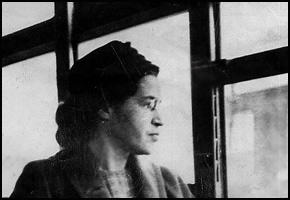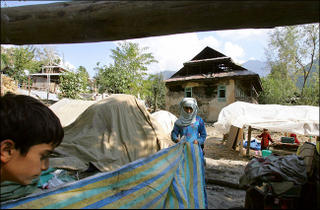Monday, October 31, 2005
Minsk, Belarus In The Fifties

The Minsk Opera and Ballet House is set in its own park and lake.
Following near total destruction by the Germans in the Second World War (the Soviet Great Patriotic War), Minsk, Belarus, in the 1950s, became the site of vast Soviet urban and architectural reconstruction -- virtually all in a Soviet neo-classical and contextual style.
For 25 historic photos of Minsk in the 50s, see http://www.data.minsk.by/minsk/fifties/index.html
Photo credit: www.data.minsk.by an independent Belarusan web-site
The Old Mir Palace Complex of Belarus

Located Southwest of Minsk, the Radziwill Mir Palace Complex has been a UNESCO World Heritage Site since 2000. Renovated wings currently serve as an Archeological Museum and as a College of Architectural Restoration.
More photos [August 2005] at http://www.data.minsk.by/history/mir/ an independent Belarusan web-site.
Photo credit: Oleg Trusov Candidate of Historical Sciences [?]
And Now A Word From My Muse
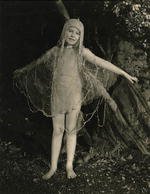
"Boo"
Helen Westcott as "Cobweb" in the Warner Bros. Production of "A Midsummer Night's Dream" directed by Max Reinhardt and William Dieterle [1935]. Cinematographer Hal Mohr is the only "write-in nominee" ever to have won an Academy Award -- for his brilliant contribution to this work.
"Erich Wolfgang Korngold, a brilliant modern opera composer from Vienna, was hired to do his very first film score, based on Felix Mendelssohn’s 1843 music for the play. The cast was a mixture of Ellis Island and Castle Garden, for, in collecting his famous stock company, Warner had unconsciously created a brilliant tapestry of American urban types, a miniature of the immigrant and working class culture he was so inescapably a part of. There was Jimmy Cagney as “Bottom,” from Ireland via Manhattan’s tough Yorkville neighborhood, where he grew up speaking fluent Yiddish and playing exquisite drag roles in settlement house revues. There was Joe E. Brown as “Flute,” an already well-cured ham from the vaudeville and burlesque boards, a Midwesterner who’d first seen the country from a circus train and the outfield of a barnstorming semi-pro baseball team. From Brooklyn by way of Hollywood came 15 year-old Mickey Rooney to play “Puck,” a trouper who’d been on stage and screen since the age of 15 months. Dick Powell’s “Lysander” was a boy singer from Mountain View, Arkansas. Victor Jory’s “Oberon” came all the way from Gold Rush-era Dawson City, Alaska, and the strenuous life of a Coast Guardsman and amateur boxer. As “Hermia,” there was even bewildered Olivia DeHavilland, girlish scion of the British merchant gentry, born in Tokyo and brought to California at age three."
Source: Kevin Hagopian, Penn State University
http://www.albany.edu/writers-inst/fns98n5.html
Une Lueur dans l'age sombre (“A Glimmer in the Age of Darkness”)
"For four hundred thousand years after the Big Bang, the universe is nothing more than frozen darkness; one calls this period "the Age of Darkness." Within this cosmic void, the cold gases slowly gather in formless masses which, in collapsing upon themselves, proceed to illuminate the first stars. It is the start of a renaissance, and the universe will begin to shine with a thousand galactic fires."... Composer Guillaume Connesson (Translated by Carl Cunningham)
Une Lueur dans l'age sombre (“A Glimmer in the Age of Darkness”), completed last July [and to be performed by the National Symphony Orchestra this Thursday to Saturday], was commissioned by the Royal Scottish National Orchestra in celebration of its first season under its new music director, Stéphane Denève, who conducted the premiere in Dundee on September 28 and repeated the performance in Aberdeen, Edinburgh and Glasgow over the following three days. Mr. Denève presided over the U.S. premiere less than a week ago, in the Houston Symphony Orchestra's concerts of October 28-30.
The score, dedicated to Stéphane Denève, calls for 2 piccolos, 2 flutes, 3 oboes, 2 clarinets, 2 bassoons, contrabassoon, 4 horns, 3 trumpets, 3 trombones, tuba, crotales (played with a double bass bow), marimbaphone, xylophone, vibraphone, glockenspiel tubular bells, 3 suspended cymbals, crash cymbals, triangle, 2 tam tams, 2 large gongs, bass drum, piano, celesta, harp and strings. Duration, 20 minutes.
(c) Musicologist Richard Freed via www.kennedy-center.org

Une Lueur dans l'age sombre (“A Glimmer in the Age of Darkness”), completed last July [and to be performed by the National Symphony Orchestra this Thursday to Saturday], was commissioned by the Royal Scottish National Orchestra in celebration of its first season under its new music director, Stéphane Denève, who conducted the premiere in Dundee on September 28 and repeated the performance in Aberdeen, Edinburgh and Glasgow over the following three days. Mr. Denève presided over the U.S. premiere less than a week ago, in the Houston Symphony Orchestra's concerts of October 28-30.
The score, dedicated to Stéphane Denève, calls for 2 piccolos, 2 flutes, 3 oboes, 2 clarinets, 2 bassoons, contrabassoon, 4 horns, 3 trumpets, 3 trombones, tuba, crotales (played with a double bass bow), marimbaphone, xylophone, vibraphone, glockenspiel tubular bells, 3 suspended cymbals, crash cymbals, triangle, 2 tam tams, 2 large gongs, bass drum, piano, celesta, harp and strings. Duration, 20 minutes.
(c) Musicologist Richard Freed via www.kennedy-center.org

A Little Light In The Darkness
"The Bill and Melinda Gates Foundation will donate $258 million to research on malaria, which kills 2,000 African children each day, Mr. Gates announced yesterday.
About $108 million will be put toward a vaccine, $100 million for new drugs, and $50 million to develop insecticides and other forms of mosquito control.
Since 1999, the foundation has donated about $230 million to malaria research. Six new drugs for the disease are now in clinical trials, compared with none five years ago, and an experimental vaccine that protects about 30 percent of inoculated children has been developed."
New York Times "Gates Announces Anti-Malaria Donation" Nytimes.com October 31, 2005

The Anopheline mosquito is responsible for the transmission of the human malaria virus (image above).
Photo Credit: University of California.
About $108 million will be put toward a vaccine, $100 million for new drugs, and $50 million to develop insecticides and other forms of mosquito control.
Since 1999, the foundation has donated about $230 million to malaria research. Six new drugs for the disease are now in clinical trials, compared with none five years ago, and an experimental vaccine that protects about 30 percent of inoculated children has been developed."
New York Times "Gates Announces Anti-Malaria Donation" Nytimes.com October 31, 2005

The Anopheline mosquito is responsible for the transmission of the human malaria virus (image above).
Photo Credit: University of California.
Thursday, October 27, 2005
Kazan: The Mosque Inside the Kremlin Walls
"David [Hilligas] and I arrived in Kazan on a brilliant, sunny Saturday afternoon, perfect for wandering around the city. We decided to start with the city's Kremlin, a massive 16th-century fortress perched on the banks of the Kazanka River.
As I stood on a grassy slope outside the Kremlin, I was shocked to find I'd completely forgotten about the giant turquoise-domed mosque towering over the walls....
The Kul Sharif mosque, completed earlier this year, towers over Kazan's Kremlin. When we went inside the Kremlin, we found a small monument commemorating a decree by the President of Tatarstan to "recreate the Kul Sharif Mosque." The decree was dated November 13, 1995 ... The mosque had been designed and built within the last ten years.
This was no small accomplishment, as the Kul Sharif mosque is not only exquisitely ornate, it is also apparently one of the largest mosques in Europe. The minarets soar 187 feet into the air, and the gleaming cupola rises 128 feet. The cavernous prayer hall reportedly can accommodate 1,500 people, in addition to another 9,000 out on the square.
Since the fall of the Soviet Union, religious faiths of all kinds have seen a gradual resurgence in Russia. It's not so surprising that a new mosque was built here, as Kazan is the capital of Tatarstan, an autonomous republic with more than 2 million mostly Muslim Tatars. But I did find it surprising that the new mosque was built right inside the Kremlin, a UNESCO World Heritage site.
As it turns out, the mosque was built on roughly the same spot as an earlier Kul Sharif mosque, which was destroyed by Ivan the [Formidable's] armies in 1552."...
Lisa Dickey "Russian Chronicles" Washington Post via WashingtonPost.com October 23, 2005.
http://whc.unesco.org/
*
There are also some interesting, and controversial, comments posted to Ms. Dickey's story on Kazan.
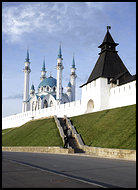
Photo credit: David Hillegas www.davidhillegas.com
As I stood on a grassy slope outside the Kremlin, I was shocked to find I'd completely forgotten about the giant turquoise-domed mosque towering over the walls....
The Kul Sharif mosque, completed earlier this year, towers over Kazan's Kremlin. When we went inside the Kremlin, we found a small monument commemorating a decree by the President of Tatarstan to "recreate the Kul Sharif Mosque." The decree was dated November 13, 1995 ... The mosque had been designed and built within the last ten years.
This was no small accomplishment, as the Kul Sharif mosque is not only exquisitely ornate, it is also apparently one of the largest mosques in Europe. The minarets soar 187 feet into the air, and the gleaming cupola rises 128 feet. The cavernous prayer hall reportedly can accommodate 1,500 people, in addition to another 9,000 out on the square.
Since the fall of the Soviet Union, religious faiths of all kinds have seen a gradual resurgence in Russia. It's not so surprising that a new mosque was built here, as Kazan is the capital of Tatarstan, an autonomous republic with more than 2 million mostly Muslim Tatars. But I did find it surprising that the new mosque was built right inside the Kremlin, a UNESCO World Heritage site.
As it turns out, the mosque was built on roughly the same spot as an earlier Kul Sharif mosque, which was destroyed by Ivan the [Formidable's] armies in 1552."...
Lisa Dickey "Russian Chronicles" Washington Post via WashingtonPost.com October 23, 2005.
http://whc.unesco.org/
*
There are also some interesting, and controversial, comments posted to Ms. Dickey's story on Kazan.

Photo credit: David Hillegas www.davidhillegas.com
Of Air Bridges, Poverty, And A Failure Of Globalization
AMERICAN RED CROSS
P.O. Box 37243
Washington, D.C. 20013
800-HELP-NOW
www.redcross.org
CARE
151 Ellis St. NE
Atlanta, Ga. 30303-2439
800-521-CARE
www.care.org
*
"Hundreds of truckloads of food, water, power generators and other supplies are being flown to Hurricane Wilma victims over a new ''air bridge'' ordered by Homeland Security Secretary Michael Chertoff.
After getting a firsthand look at long lines of cars waiting at gas stations and an earful of complaints about shortages from local officials, Chertoff ordered his department to step up shipments by keeping aircraft moving round the clock between south Florida and depots around the country.
The same nonstop airlift capacity was developed after Hurricane Katrina in order to evacuate victims, he said.
''The idea is to just run aircraft in a circle, back-to-back,'' Chertoff said. ''They'll fly the delivery, they'll come back and get more -- as long as it takes.''" ...
Associated Press "Chertoff Orders 'Air Bridge' for Wilma Aid" October 27, 2005 via WashingtonPost.com
*
Now where have I heard of the need for an "Air Bridge" before?
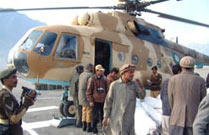
The survivors of the latest Pakistan/India Earthquake are now sleeping out in the open in freezing winter temperatures, which in this mountainous region can reach as low as -15°C (5°F).
Photo credit: www.islamic-relief.com
P.O. Box 37243
Washington, D.C. 20013
800-HELP-NOW
www.redcross.org
CARE
151 Ellis St. NE
Atlanta, Ga. 30303-2439
800-521-CARE
www.care.org
*
"Hundreds of truckloads of food, water, power generators and other supplies are being flown to Hurricane Wilma victims over a new ''air bridge'' ordered by Homeland Security Secretary Michael Chertoff.
After getting a firsthand look at long lines of cars waiting at gas stations and an earful of complaints about shortages from local officials, Chertoff ordered his department to step up shipments by keeping aircraft moving round the clock between south Florida and depots around the country.
The same nonstop airlift capacity was developed after Hurricane Katrina in order to evacuate victims, he said.
''The idea is to just run aircraft in a circle, back-to-back,'' Chertoff said. ''They'll fly the delivery, they'll come back and get more -- as long as it takes.''" ...
Associated Press "Chertoff Orders 'Air Bridge' for Wilma Aid" October 27, 2005 via WashingtonPost.com
*
Now where have I heard of the need for an "Air Bridge" before?

The survivors of the latest Pakistan/India Earthquake are now sleeping out in the open in freezing winter temperatures, which in this mountainous region can reach as low as -15°C (5°F).
Photo credit: www.islamic-relief.com
Tuesday, October 25, 2005
Towards A Marriage Of The Renaissance And Contemporary
Shelters from the storm... Today at noon Michael Harrison
leads his fine Palestrina Choir in a free hour long
performance at Church of the Epiphany, 1317 G Street NW,
Washington, D.C., next to the Metro Center metro stop.
Then, tomorrow evening, October 26, at 7:30 PM,
the YL Male Voice Choir from Helsinki, Finland performs a
concert of music by Sibelius, Rautavaara, Randall Thompson,
Tormis, Yuasa, and Kuula at St. Mark's Episcopal Church,
Third and A Streets, SE, Washington, D.C., next to the
Capital South metro stop.

Oleg Kudryashov Icon 1991.
Completed by Kudryashov while living in exile in London from
1974 to 1995, and prior to his return to Moscow. The image
is his memory of his family's Orthodox Icon which they donated
to a Russian Orthodox Church. The central image is surrounded
by sketches of the hardships and absurdities of contemporary
modern life. (I own a unique edition of this large print, which
has a black book in the central image.)
Photo credit: Courtesy of Robert Brown Gallery.
leads his fine Palestrina Choir in a free hour long
performance at Church of the Epiphany, 1317 G Street NW,
Washington, D.C., next to the Metro Center metro stop.
Then, tomorrow evening, October 26, at 7:30 PM,
the YL Male Voice Choir from Helsinki, Finland performs a
concert of music by Sibelius, Rautavaara, Randall Thompson,
Tormis, Yuasa, and Kuula at St. Mark's Episcopal Church,
Third and A Streets, SE, Washington, D.C., next to the
Capital South metro stop.
Oleg Kudryashov Icon 1991.
Completed by Kudryashov while living in exile in London from
1974 to 1995, and prior to his return to Moscow. The image
is his memory of his family's Orthodox Icon which they donated
to a Russian Orthodox Church. The central image is surrounded
by sketches of the hardships and absurdities of contemporary
modern life. (I own a unique edition of this large print, which
has a black book in the central image.)
Photo credit: Courtesy of Robert Brown Gallery.
Monday, October 24, 2005
Healthy Nationalism, Human Capital Migration, and Human Development
"Poor countries across Africa, Central America and the Caribbean are losing sometimes staggering numbers of their college-educated workers to wealthy, industrialized democracies, according to a World Bank study made public today.
Its conclusions are based on a far-reaching survey of census and other data from the 30 countries that belong to the Organization for Economic Cooperation and Development, which counts most of the world's richest nations among its members.
Researchers found, for example, that a quarter to almost half of the college-educated nationals of Ghana, Mozambique, Kenya, Uganda, Nicaragua and El Salvador live in [OECD] member countries. For Haiti and Jamaica, the number rises to more than 80 percent.
In contrast, less than 5 percent of the skilled nationals of the great behemoths of the developing world - India, China, Indonesia and Brazil - live in [an OECD] member country.
The World Bank's study is part of a broader intellectual ferment about the role that migration plays in the development of poor countries."...
Celia W. Dugger "Educated Workers Leaving Poor Nations, Survey Finds" Nytimes.com October 24, 2005.
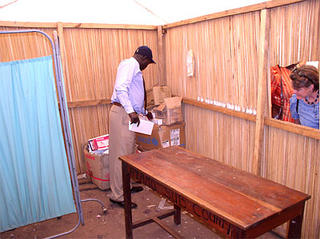
The health center in the Internally Displaced Persons (IDP) Camp and Hospital in Northern Uganda is staffed by only one nurse and a nurse's assistant who treat an average of 150-200 cases per day. The most common health problems include malaria, scabies, diarrhea, and intestinal worms. The camp's only clinic serves 14,188 people.
Photo credit: U.S.A.I.D.
Its conclusions are based on a far-reaching survey of census and other data from the 30 countries that belong to the Organization for Economic Cooperation and Development, which counts most of the world's richest nations among its members.
Researchers found, for example, that a quarter to almost half of the college-educated nationals of Ghana, Mozambique, Kenya, Uganda, Nicaragua and El Salvador live in [OECD] member countries. For Haiti and Jamaica, the number rises to more than 80 percent.
In contrast, less than 5 percent of the skilled nationals of the great behemoths of the developing world - India, China, Indonesia and Brazil - live in [an OECD] member country.
The World Bank's study is part of a broader intellectual ferment about the role that migration plays in the development of poor countries."...
Celia W. Dugger "Educated Workers Leaving Poor Nations, Survey Finds" Nytimes.com October 24, 2005.

The health center in the Internally Displaced Persons (IDP) Camp and Hospital in Northern Uganda is staffed by only one nurse and a nurse's assistant who treat an average of 150-200 cases per day. The most common health problems include malaria, scabies, diarrhea, and intestinal worms. The camp's only clinic serves 14,188 people.
Photo credit: U.S.A.I.D.
The Dwindling Of Compassion
AMERICAN RED CROSS
P.O. Box 37243
Washington, D.C. 20013
800-HELP-NOW
www.redcross.org
CARE
151 Ellis St. NE
Atlanta, Ga. 30303-2439
800-521-CARE
www.care.org
"The catastrophic earthquake that devastated parts of Pakistan and India this month has strained the ability of many international relief organizations to raise funds from American donors, many of whom feel overwhelmed by appeals for what has been an unusually high number of major disasters this year.
So far donations to about a dozen major relief groups for the 7.6-magnitude temblor -- which may have killed as many as 40,000 [79,000] people and left more than a million [3 million] people homeless -- have totaled $13.1-million. If donations continue at the current pace, these groups would receive only a fraction of what was raised for the Indian Ocean tsunamis, which totaled $1.3-billion, or for Hurricane Katrina, which to date comes to $1.8-billion.
Save the Children, which has been providing tents, blankets, and other supplies to Pakistanis in Muzzafarabad and other cities rocked by the quake, received $1.3-million in the 10 days after the earthquake struck. By comparison, the group had raised $5-million just five days after the tsunamis swept through South Asia last December.
Mark Melia, a fund raiser at Catholic Relief Services, in Baltimore, said he worries that with so many natural disasters, it's easy for donors to lose sight of the magnitude of the South Asian earthquake. His organization had raised $1.1-million for the earthquake as of last week."...
Nicole Wallace and Ian Wilhelm "Earthquake Taxes Capacity of Donors and Charities to Provide Relief Aid" The Chronicles Of Philanthropy: Update" October 20, 2005.

Earlier this year at the Port of Karachi, Pakistan Navy soldiers load vegetables for the tsunami victims onto a ship bound for Sri Lanka and Indonesia.
Photo credit: Pakistan Times.
P.O. Box 37243
Washington, D.C. 20013
800-HELP-NOW
www.redcross.org
CARE
151 Ellis St. NE
Atlanta, Ga. 30303-2439
800-521-CARE
www.care.org
"The catastrophic earthquake that devastated parts of Pakistan and India this month has strained the ability of many international relief organizations to raise funds from American donors, many of whom feel overwhelmed by appeals for what has been an unusually high number of major disasters this year.
So far donations to about a dozen major relief groups for the 7.6-magnitude temblor -- which may have killed as many as 40,000 [79,000] people and left more than a million [3 million] people homeless -- have totaled $13.1-million. If donations continue at the current pace, these groups would receive only a fraction of what was raised for the Indian Ocean tsunamis, which totaled $1.3-billion, or for Hurricane Katrina, which to date comes to $1.8-billion.
Save the Children, which has been providing tents, blankets, and other supplies to Pakistanis in Muzzafarabad and other cities rocked by the quake, received $1.3-million in the 10 days after the earthquake struck. By comparison, the group had raised $5-million just five days after the tsunamis swept through South Asia last December.
Mark Melia, a fund raiser at Catholic Relief Services, in Baltimore, said he worries that with so many natural disasters, it's easy for donors to lose sight of the magnitude of the South Asian earthquake. His organization had raised $1.1-million for the earthquake as of last week."...
Nicole Wallace and Ian Wilhelm "Earthquake Taxes Capacity of Donors and Charities to Provide Relief Aid" The Chronicles Of Philanthropy: Update" October 20, 2005.

Earlier this year at the Port of Karachi, Pakistan Navy soldiers load vegetables for the tsunami victims onto a ship bound for Sri Lanka and Indonesia.
Photo credit: Pakistan Times.
"Science and the Renewal of Musical Aesthetics" -- Conference - Debate
"From singing to the crafting of a violin to the multimedia creation of sound, science continually contributes to the renewal of musical aesthetics.
The CNRS (The French National Center for Scientific Research) Office in Washington and the Office of Science and Technology of the Embassy of France have organized a series of events for October 28th, 2005 that aim to illustrate the age-old dialogue between science and music. Thanks to this dialogue, the expertise of both singers and stringed instrument makers serve as inexhaustible sources of questioning, which in turn leads to research requiring the most recent data in the physical and social sciences. The results of these studies open the door to new approaches and permit innovation in a field known for being very reluctant to change.
The participants will present their recent work on the human voice and on stringed instruments that give an account of this research. The events will close with an exciting presentation of the Meta-Instrument, which will demonstrate the roles of images and synthesized sounds in the elaboration of musical aesthetics...
With the participation of Joseph Curtin, stringed instrument maker and Benoît Rolland, bow maker."...
http://www.la-maison-francaise.org/en_conf.htm

The CNRS (The French National Center for Scientific Research) Office in Washington and the Office of Science and Technology of the Embassy of France have organized a series of events for October 28th, 2005 that aim to illustrate the age-old dialogue between science and music. Thanks to this dialogue, the expertise of both singers and stringed instrument makers serve as inexhaustible sources of questioning, which in turn leads to research requiring the most recent data in the physical and social sciences. The results of these studies open the door to new approaches and permit innovation in a field known for being very reluctant to change.
The participants will present their recent work on the human voice and on stringed instruments that give an account of this research. The events will close with an exciting presentation of the Meta-Instrument, which will demonstrate the roles of images and synthesized sounds in the elaboration of musical aesthetics...
With the participation of Joseph Curtin, stringed instrument maker and Benoît Rolland, bow maker."...
http://www.la-maison-francaise.org/en_conf.htm

Zem spieva
VIDUITSY, Belarus - "The winter rye is already sprouting green in the undulating fields of the state cooperative farm here. The summer's crop - rye, barley and rapeseed - amounted to 1,400 tons. Best of all, the farm's director, Vladimir I. Pryzhenkov, said, none of it tested radioactive.
That is progress. The farm's 4,000 acres are nestled among some of the most contaminated spots on earth, the poisoned legacy of the worst nuclear accident in history: the explosion at Chernobyl Reactor No. 4 on April 26, 1986.
Nearly a quarter of Belarus, including some of its prime farmland, remains radioactive to some degree. Mr. Pryzhenkov's farm represents part of the government's efforts to put the contaminated lands back to good use.
The farm, no longer known as the Karl Marx collective but still state-owned, reopened two years ago with the millions of dollars' worth of harvesters, tractors and other equipment provided by President Aleksandr G. Lukashenko's government.
A year before that the checkpoints that once restricted access to this region, 150 miles from Chernobyl, disappeared. Families began returning. Some had never left; all needed jobs."...
Steven Lee Myers "Belarus Resumes Farming in Chernobyl Radiation Zone" Nytimes.com October 22, 2005.
*
Last night, N. told me how her Tartar grandfather after, apparently, miraculously surviving a bullet wound in the First World War, returned to his village and became a respected folk-healer. Later, when N.'s father had malaria as a young boy, the grandfather fed his son crawfish broth for weeks on end to restore the son's health and immune system.

Crawfish
Photo credit: (c) Paul Kay via www.english-nature.org.uk
That is progress. The farm's 4,000 acres are nestled among some of the most contaminated spots on earth, the poisoned legacy of the worst nuclear accident in history: the explosion at Chernobyl Reactor No. 4 on April 26, 1986.
Nearly a quarter of Belarus, including some of its prime farmland, remains radioactive to some degree. Mr. Pryzhenkov's farm represents part of the government's efforts to put the contaminated lands back to good use.
The farm, no longer known as the Karl Marx collective but still state-owned, reopened two years ago with the millions of dollars' worth of harvesters, tractors and other equipment provided by President Aleksandr G. Lukashenko's government.
A year before that the checkpoints that once restricted access to this region, 150 miles from Chernobyl, disappeared. Families began returning. Some had never left; all needed jobs."...
Steven Lee Myers "Belarus Resumes Farming in Chernobyl Radiation Zone" Nytimes.com October 22, 2005.
*
Last night, N. told me how her Tartar grandfather after, apparently, miraculously surviving a bullet wound in the First World War, returned to his village and became a respected folk-healer. Later, when N.'s father had malaria as a young boy, the grandfather fed his son crawfish broth for weeks on end to restore the son's health and immune system.

Crawfish
Photo credit: (c) Paul Kay via www.english-nature.org.uk
Where's The Unbearable Lightness of Being?
On paper, it looked like a fine and full Sunday afternoon and evening cultural package -- one at no direct cost to me. After Belgian waffles, fruit, and salad at home, we would take a brief walk along the C & O Canal, and then take the bus over to the National Gallery of Art for Alexander Nagel's Andrew W. Mellon lecture "Renaissance Art Discovers the Icon", then attend the screening of the new Italian film "I'm Not Scared (Io non ho paura)" (Gabriele Salvatores, 2003, Italian with subtitles, from the novel by Niccolò Ammaniti, 109 minutes, Recommended for mature audiences)["One of the most lauded Italian releases of the last two years is this suspense thriller about a ten-year-old boy in rural southern Italy who one day finds a boy his age imprisoned in a pit on the verge of perishing. How the boy handles this grim and evil reality, especially in the face of a curious adult indifference, is the film's epic power"], and then stay on for at least half of the free Takacs String Quartet concert at the National Gallery, at 6:30 PM, of works of Haydn, Beethoven, and Borodin.
Instead, the sun was shining, and we somehow ended up -- halfway in the sun -- in Leopold's Viennese Cafe, in a gentrified industrial alley above the Canal, drinking coffee and eating Brautwurst and chatting with the friendly guests at the neighbouring small tables. The hours melted away, and we then found ourselves at the granite end of the destroyed Civil War era railroad bridge over the Potomac River, and then sunning ourselves at Arthur Cotton Moore's Georgetown Harborplace "folly", before hopping on the 50 minute Potomac River tour boat excursion. I protested that we had already done the boat ride by moonlight and the leaves hadn't yet turned color, but I was overruled -- Boatride or no Takacs String Quartet concert later.
Well, we didn't make it to the Takacs String Quartet concert either, instead finding our way back to the old church-yard of Grace Church ("a little Episcopal parish in lower Georgetown, Washington, D.C. with a very big heart" [above the river and next to the new Ritz Luxury Hotel and Residences])where a young group of jazz students had earlier been rehearsed by a very patient and kindly elderly African American jazz master, bassist Emory Diggs. There, we attended a presentation of Russian and Ukrainian Orthodox and Folk Music and Dance, by a young troupe of ten (eight girls and two boys) from a Southern Russian orphanage near Orenburg. The troupe and tour was being sponsored by St. John’s Russian Orthodox Cathedral in Connecticut and (the also affluent) Christ Episcopal Church, in Washington. It was a fine and varied cultural afternoon program after all; complementing the jazz rehearsal that we had heard earlier. I especially enjoyed the Russian and Ukrainian folksongs sung by two teenage boys who accompanied themselves on gusli and guitar. This troupe of young spiritual artists travelled as spiritual artists have always travelled -- sleeping on stages or between the pews of churches. The few hundred -- or perhaps thousand dollars -- these spiritual artists would earn would sustain their orphanage of 60 children through the coming winter and until the next world tour...
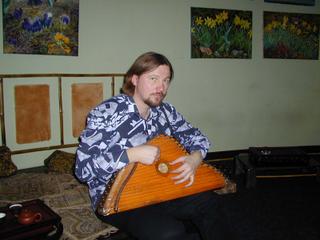
Slavonic gusli
Photo credit: East-Club, Russia www.east-club.ru
Instead, the sun was shining, and we somehow ended up -- halfway in the sun -- in Leopold's Viennese Cafe, in a gentrified industrial alley above the Canal, drinking coffee and eating Brautwurst and chatting with the friendly guests at the neighbouring small tables. The hours melted away, and we then found ourselves at the granite end of the destroyed Civil War era railroad bridge over the Potomac River, and then sunning ourselves at Arthur Cotton Moore's Georgetown Harborplace "folly", before hopping on the 50 minute Potomac River tour boat excursion. I protested that we had already done the boat ride by moonlight and the leaves hadn't yet turned color, but I was overruled -- Boatride or no Takacs String Quartet concert later.
Well, we didn't make it to the Takacs String Quartet concert either, instead finding our way back to the old church-yard of Grace Church ("a little Episcopal parish in lower Georgetown, Washington, D.C. with a very big heart" [above the river and next to the new Ritz Luxury Hotel and Residences])where a young group of jazz students had earlier been rehearsed by a very patient and kindly elderly African American jazz master, bassist Emory Diggs. There, we attended a presentation of Russian and Ukrainian Orthodox and Folk Music and Dance, by a young troupe of ten (eight girls and two boys) from a Southern Russian orphanage near Orenburg. The troupe and tour was being sponsored by St. John’s Russian Orthodox Cathedral in Connecticut and (the also affluent) Christ Episcopal Church, in Washington. It was a fine and varied cultural afternoon program after all; complementing the jazz rehearsal that we had heard earlier. I especially enjoyed the Russian and Ukrainian folksongs sung by two teenage boys who accompanied themselves on gusli and guitar. This troupe of young spiritual artists travelled as spiritual artists have always travelled -- sleeping on stages or between the pews of churches. The few hundred -- or perhaps thousand dollars -- these spiritual artists would earn would sustain their orphanage of 60 children through the coming winter and until the next world tour...

Slavonic gusli
Photo credit: East-Club, Russia www.east-club.ru
Friday, October 21, 2005
The King Speaks to the Scribe II
AMERICAN RED CROSS
P.O. Box 37243
Washington, D.C. 20013
800-HELP-NOW
www.redcross.org
CARE
151 Ellis St. NE
Atlanta, Ga. 30303-2439
800-521-CARE
www.care.org
"United Nations and private aid workers said Thursday that the pressing need to shelter up to three million Pakistani earthquake survivors before the harsh Himalayan winter sets in was threatening to become the most difficult relief operation the world has ever faced.
In the refugee camp at Balakot, Pakistan, an earthquake survivor shivered in the rain. In the background at left are Pakistani soldiers. Compounding the problems posed by the sheer number of people displaced - three times as many as those affected by the Indian Ocean tsunami last December - are the mountainous terrain and the onset of a winter that is likely to arrive in less than three weeks and sever the stricken mountain hamlets of the north from the rest of the country until spring.
And yet, perhaps out of fatigue after a year of seemingly endless natural disasters, aid officials say, the international response has been weak...."
Somini Sengupta and David Phode "Winter Is the Enemy for Quake's Homeless Millions" New York Times, October 21, 2005.
*
UPDATE: "NATO allies agreed Friday to dispatch hundreds of military engineers, medics and other troops to reinforce the earthquake relief effort in Pakistan.
The alliance also said it was stepping up its airlift of aid to Pakistan from Europe, but continued to struggle to find helicopters that are desperately needed to rush aid into the high mountains of Kashmir and northern Pakistan."
Associated Press "NATO to Send Engineers, Medics to Pakistan " via Nytimes.com October 21, 2005 11:27 AM ET
Now, where or where might thousands of other military engineers, medics, and other troops -- as well as hundreds, if not thousands of helicopters -- possibly be? And where or where might the world immediately find tens of thousands of winterized tents?
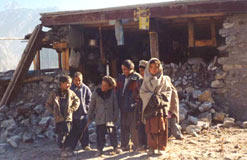
Pakistani children outside a collapsed building.
Photo credit: www.islamic-relief.com
P.O. Box 37243
Washington, D.C. 20013
800-HELP-NOW
www.redcross.org
CARE
151 Ellis St. NE
Atlanta, Ga. 30303-2439
800-521-CARE
www.care.org
"United Nations and private aid workers said Thursday that the pressing need to shelter up to three million Pakistani earthquake survivors before the harsh Himalayan winter sets in was threatening to become the most difficult relief operation the world has ever faced.
In the refugee camp at Balakot, Pakistan, an earthquake survivor shivered in the rain. In the background at left are Pakistani soldiers. Compounding the problems posed by the sheer number of people displaced - three times as many as those affected by the Indian Ocean tsunami last December - are the mountainous terrain and the onset of a winter that is likely to arrive in less than three weeks and sever the stricken mountain hamlets of the north from the rest of the country until spring.
And yet, perhaps out of fatigue after a year of seemingly endless natural disasters, aid officials say, the international response has been weak...."
Somini Sengupta and David Phode "Winter Is the Enemy for Quake's Homeless Millions" New York Times, October 21, 2005.
*
UPDATE: "NATO allies agreed Friday to dispatch hundreds of military engineers, medics and other troops to reinforce the earthquake relief effort in Pakistan.
The alliance also said it was stepping up its airlift of aid to Pakistan from Europe, but continued to struggle to find helicopters that are desperately needed to rush aid into the high mountains of Kashmir and northern Pakistan."
Associated Press "NATO to Send Engineers, Medics to Pakistan " via Nytimes.com October 21, 2005 11:27 AM ET
Now, where or where might thousands of other military engineers, medics, and other troops -- as well as hundreds, if not thousands of helicopters -- possibly be? And where or where might the world immediately find tens of thousands of winterized tents?

Pakistani children outside a collapsed building.
Photo credit: www.islamic-relief.com
Thursday, October 20, 2005
A Second Berlin Air Bridge Needed
AMERICAN RED CROSS
P.O. Box 37243
Washington, D.C. 20013
800-HELP-NOW
www.redcross.org
CARE
151 Ellis St. NE
Atlanta, Ga. 30303-2439
800-521-CARE
www.care.org
"The top U.N. relief coordinator warned Thursday that bold initiatives like the Berlin Airlift are needed to save as many as 3 million people left homeless by the South Asian earthquake as winter approaches in the Himalayas.
The World Health Organization, meanwhile, reported three quake survivors died of tetanus, reinforcing fears that disease and infected injuries could drive the 79,000 death toll far higher.
Jan Egeland, the U.N. relief coordinator, appealed to NATO and other potential donors to step in with an army of helicopters to fly in relief supplies and evacuate perhaps hundreds of thousands of people.
"The world is not doing enough," Egeland said in Geneva. "We should be able to do this."
He called for "a second Berlin air bridge" -- nonstop flights reminiscent of the U.S. and British airlift of essential supplies into West Berlin in the late 1940s when Soviet troops blocked the city's road links to the West for nearly 11 months. At one point, cargo planes landed in West Berlin at the rate of one a minute."
Munir Ahmad "U.N.: Berlin-Type Airlift Needed in Asia" AP via WashingtonPost.com October 20, 2005.

The Berlin Airlift, 1948-1949. Crews unloading flour.
"At one point, cargo planes landed in West Berlin at the rate of one a minute."
Photo credit: (c) copyright, Brooklyn College History Dept, 1997
academic.brooklyn.cuny.edu/. ../0255/img0047.jpg
P.O. Box 37243
Washington, D.C. 20013
800-HELP-NOW
www.redcross.org
CARE
151 Ellis St. NE
Atlanta, Ga. 30303-2439
800-521-CARE
www.care.org
"The top U.N. relief coordinator warned Thursday that bold initiatives like the Berlin Airlift are needed to save as many as 3 million people left homeless by the South Asian earthquake as winter approaches in the Himalayas.
The World Health Organization, meanwhile, reported three quake survivors died of tetanus, reinforcing fears that disease and infected injuries could drive the 79,000 death toll far higher.
Jan Egeland, the U.N. relief coordinator, appealed to NATO and other potential donors to step in with an army of helicopters to fly in relief supplies and evacuate perhaps hundreds of thousands of people.
"The world is not doing enough," Egeland said in Geneva. "We should be able to do this."
He called for "a second Berlin air bridge" -- nonstop flights reminiscent of the U.S. and British airlift of essential supplies into West Berlin in the late 1940s when Soviet troops blocked the city's road links to the West for nearly 11 months. At one point, cargo planes landed in West Berlin at the rate of one a minute."
Munir Ahmad "U.N.: Berlin-Type Airlift Needed in Asia" AP via WashingtonPost.com October 20, 2005.

The Berlin Airlift, 1948-1949. Crews unloading flour.
"At one point, cargo planes landed in West Berlin at the rate of one a minute."
Photo credit: (c) copyright, Brooklyn College History Dept, 1997
academic.brooklyn.cuny.edu/. ../0255/img0047.jpg
Of Blindfolded Musicians and Blindfolded Orchestral Adminstrators
"Classic Attitude represents the first real attempt by a major Australian orchestra to create a coordinated marketing mix aimed at satisfying the needs of the 18-35-year-old market.
Much has been made of the [Melbourne Symphony Orchestra] promotion of Classic Attitude in the popular press, for it tackled head-on the traditional image of classical music, addressing the concerns of the younger audience directly. The initial launch [in 1995] of Classic Attitude featured an attractive model, in jeans and singlet, reclining on a pile of sheet music, with the slogan 'Lose yourself in the music'. The 1996 posters were more stylised, featuring a blindfolded violinist with the slogans 'The new sensation' and 'Brace yourself'. These advertisements clearly respond to concerns raised in focus groups, where symphonies were not thought to be as involving an experience as cinemas or other entertainment forms....
In line with the musical programs chosen, the communications focused on the 'experience' of seeing a symphony live, and on the dynamics of a large orchestra working together. The desired elements were all present, with the advertisements not only gaining attention, but more importantly illustrating the intention of MSO to innovate and be unconventional. The subtle sadomasochistic imagery of the blindfolded musicians also served to suggest an excitement not usually associated with the staid world of classical music....
In 1998, the Classic Attitude promotions moved away from psychedelic bright images towards a more sophisticated look. Such a move reinforced the unique benefits of the symphony, rather than positioning it directly against other pop culture events such as rock concerts. MSO decided to focus on its new chief conductor and artistic director, Markus Stenz, in its promotion. Stenz was not only a talented and world-renowned conductor, but was also young and attractive, making him a perfect focal point for Classic Attitude communications.... One strong trend was the demand for more modern and challenging orchestral pieces, a result of many subscribers having learnt more about the music over the past three seasons. Classic Attitude featured more twentieth-century music in 1998 [!]."
Ruth Rentschler "Innovative Arts Marketing: Melbourne Symphony Orchestra - Targeting Youth Audiences"
http://www.allenandunwin.com/extracts/pdfs/1864489936.pdf

The Hong Kong Chinese Orchestra. Towards a Contemporary Orchestral Classicism Beyond Sadomasochism?
Much has been made of the [Melbourne Symphony Orchestra] promotion of Classic Attitude in the popular press, for it tackled head-on the traditional image of classical music, addressing the concerns of the younger audience directly. The initial launch [in 1995] of Classic Attitude featured an attractive model, in jeans and singlet, reclining on a pile of sheet music, with the slogan 'Lose yourself in the music'. The 1996 posters were more stylised, featuring a blindfolded violinist with the slogans 'The new sensation' and 'Brace yourself'. These advertisements clearly respond to concerns raised in focus groups, where symphonies were not thought to be as involving an experience as cinemas or other entertainment forms....
In line with the musical programs chosen, the communications focused on the 'experience' of seeing a symphony live, and on the dynamics of a large orchestra working together. The desired elements were all present, with the advertisements not only gaining attention, but more importantly illustrating the intention of MSO to innovate and be unconventional. The subtle sadomasochistic imagery of the blindfolded musicians also served to suggest an excitement not usually associated with the staid world of classical music....
In 1998, the Classic Attitude promotions moved away from psychedelic bright images towards a more sophisticated look. Such a move reinforced the unique benefits of the symphony, rather than positioning it directly against other pop culture events such as rock concerts. MSO decided to focus on its new chief conductor and artistic director, Markus Stenz, in its promotion. Stenz was not only a talented and world-renowned conductor, but was also young and attractive, making him a perfect focal point for Classic Attitude communications.... One strong trend was the demand for more modern and challenging orchestral pieces, a result of many subscribers having learnt more about the music over the past three seasons. Classic Attitude featured more twentieth-century music in 1998 [!]."
Ruth Rentschler "Innovative Arts Marketing: Melbourne Symphony Orchestra - Targeting Youth Audiences"
http://www.allenandunwin.com/extracts/pdfs/1864489936.pdf

The Hong Kong Chinese Orchestra. Towards a Contemporary Orchestral Classicism Beyond Sadomasochism?
Festival Of China -- The Reality Version
"Beijing's new airport is rising from the dry plains east of the city so fast that, in just four years, China will have designed, built and opened a structure larger than all the terminals at Heathrow combined. That's rather less time than the lawyers spent arguing about Heathrow's Terminal 5. 'It's the world's largest and most advanced airport building,' says the project's architect, Norman Foster. With airports at Stansted and Hong Kong already under his belt, he should know better than anyone. But it still looks more like a medieval battlefield conceived on the scale of a Japanese epic, rather than the sleek glass-and-steel bubble shown in Foster's glittering computer renderings. Swarming warrior armies cluster around giant cranes, more than 100 of them, ranged like ancient siege engines across a frontline almost two miles long. The dust swirling across the landscape makes it impossible to count more than a few of them before they disappear into the acrid haze....
'The airport will be the gateway to the city,' says Foster. 'It's advanced not only technologically, but also in terms of passenger experience, operational efficiency and sustainability. It will be welcoming and uplifting, a symbol of place, its soaring aerodynamic roof and dragon-like form will celebrate the thrill and poetry of flight and evoke traditional Chinese colours and symbols.'
In short, the airport is not simply about shifting large numbers of people in and out of the city. Just as important will be its part in the conspicuous assertion of a new kind of China and its modernity. It is one of a dozen huge projects Beijing is building at furious speed to transform the city in time for the Olympic games of 2008....
Beijing is the capital of the world's fastest-growing economy, provoking a titanic struggle between a totalitarian political system and the liberalisation that is the presumed product of its economic transformation. By some estimates, half the world's annual production of concrete and one-third of its steel output is being consumed by China's construction boom...."
Deyan Sudjic "The City That Ate The World" The Observer October 16, 2005.

Herzog & De Meuron's winning - design for Beijing's National Stadium (2008 Olympic Stadium)
"The Swiss firm proposed a seemingly random, lattice-like network of concrete strips forming the stadium's bowl shape, resembling a "bird's nest", in the architect's words. Gaps between the concrete structure would be filled with "inflatable cushions", another phrase the architects used to describe their innovative design."
Credits: Herzog & De Meuron and http://www.archidose.org/
'The airport will be the gateway to the city,' says Foster. 'It's advanced not only technologically, but also in terms of passenger experience, operational efficiency and sustainability. It will be welcoming and uplifting, a symbol of place, its soaring aerodynamic roof and dragon-like form will celebrate the thrill and poetry of flight and evoke traditional Chinese colours and symbols.'
In short, the airport is not simply about shifting large numbers of people in and out of the city. Just as important will be its part in the conspicuous assertion of a new kind of China and its modernity. It is one of a dozen huge projects Beijing is building at furious speed to transform the city in time for the Olympic games of 2008....
Beijing is the capital of the world's fastest-growing economy, provoking a titanic struggle between a totalitarian political system and the liberalisation that is the presumed product of its economic transformation. By some estimates, half the world's annual production of concrete and one-third of its steel output is being consumed by China's construction boom...."
Deyan Sudjic "The City That Ate The World" The Observer October 16, 2005.

Herzog & De Meuron's winning - design for Beijing's National Stadium (2008 Olympic Stadium)
"The Swiss firm proposed a seemingly random, lattice-like network of concrete strips forming the stadium's bowl shape, resembling a "bird's nest", in the architect's words. Gaps between the concrete structure would be filled with "inflatable cushions", another phrase the architects used to describe their innovative design."
Credits: Herzog & De Meuron and http://www.archidose.org/
Renaissance Of Russian Filmmaking
"The young soldiers, unsure what they're fighting for or even where, are abandoned on a lonely plateau that is eventually overrun by a faceless enemy. After a bloody but heroic denouement, the lone survivor is left to return to a home country that is itself in crisis, where his experience will be ignored if not scorned.
This plot of myriad American movies about Vietnam is in fact the story line of a new and hugely successful Russian film about the Soviet war in Afghanistan, a 10-year military folly that ended in 1989. Russians are flocking to see "Company 9," the first blockbuster about the Soviet experience in Afghanistan and one that pulls no punches about the bitterness of defeat.
"During the Soviet Union there was no possibility to make such a film," said Fyodor Bondarchuk, the film's 38-year-old director, who served in the Soviet army from 1985 to 1987. "And for a long time Russia didn't want such a film because Russia didn't want to remember this 10 years of shame. It's an incredible success for a serious film and it shows the audience is ready to think."
Russia's film industry, crumbling just five years ago, is suddenly resurgent and a host of movies including "Company 9" are drawing Russian audiences away from Hollywood staples...."
Peter Finn "From Bitter Memories, A Russian Blockbuster" WashingtonPost.com October 20, 2005.
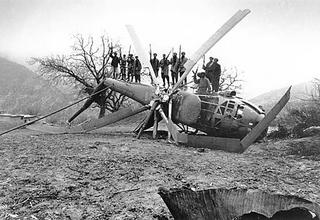
"Mujahideen (Islamic guerrillas) stand on top of a Soviet helicopter they brought down in Afghanistan in 1979. Saudi multimillionaire Osama bin Laden helped finance training camps for the mujahideen, who fought against the Soviet Union’s military occupation of Afghanistan and were trained by the United States Central Intelligence Agency (CIA). Thousands of these guerrilla fighters later joined the al-Qaeda terrorist network that bin Laden founded after the Soviets were ousted."
Photo and photo text credit: Archive Photos/Getty Images and encarta.msn.com
This plot of myriad American movies about Vietnam is in fact the story line of a new and hugely successful Russian film about the Soviet war in Afghanistan, a 10-year military folly that ended in 1989. Russians are flocking to see "Company 9," the first blockbuster about the Soviet experience in Afghanistan and one that pulls no punches about the bitterness of defeat.
"During the Soviet Union there was no possibility to make such a film," said Fyodor Bondarchuk, the film's 38-year-old director, who served in the Soviet army from 1985 to 1987. "And for a long time Russia didn't want such a film because Russia didn't want to remember this 10 years of shame. It's an incredible success for a serious film and it shows the audience is ready to think."
Russia's film industry, crumbling just five years ago, is suddenly resurgent and a host of movies including "Company 9" are drawing Russian audiences away from Hollywood staples...."
Peter Finn "From Bitter Memories, A Russian Blockbuster" WashingtonPost.com October 20, 2005.

"Mujahideen (Islamic guerrillas) stand on top of a Soviet helicopter they brought down in Afghanistan in 1979. Saudi multimillionaire Osama bin Laden helped finance training camps for the mujahideen, who fought against the Soviet Union’s military occupation of Afghanistan and were trained by the United States Central Intelligence Agency (CIA). Thousands of these guerrilla fighters later joined the al-Qaeda terrorist network that bin Laden founded after the Soviets were ousted."
Photo and photo text credit: Archive Photos/Getty Images and encarta.msn.com
Wednesday, October 19, 2005
Death Toll in Asian Quake Soars to 79,000
AMERICAN RED CROSS
P.O. Box 37243
Washington, D.C. 20013
800-HELP-NOW
www.redcross.org
CARE
151 Ellis St. NE
Atlanta, Ga. 30303-2439
800-521-CARE
www.care.org
"The death toll soared to 79,000 Wednesday from South Asia's mammoth earthquake, following a survey of one of the two hardest-hit Pakistani regions - making it one of the deadliest quakes in modern times.
More aftershocks rattled the region, sending up huge clouds of dust from steep-sided mountain valleys where villages lie in pieces. During a helicopter tour of the ruins, the president promised new, quake-ready houses for the homeless. ...
At Nanseri, a village four miles from the Line of Control in Kashmir, injured people were still emerging from their communities _ making arduous journeys across towering mountains, with relatives carrying their loved ones on their backs or in wooden-and-twine beds."
Matthew Pennington "Death Toll in Asian Quake Soars to 79,000" AP via WashingtonPost.com October 19, 2005.
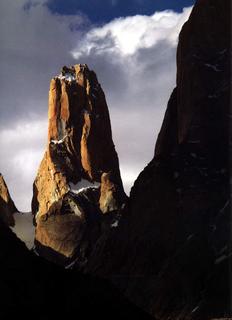
Photo credit:
P.O. Box 37243
Washington, D.C. 20013
800-HELP-NOW
www.redcross.org
CARE
151 Ellis St. NE
Atlanta, Ga. 30303-2439
800-521-CARE
www.care.org
"The death toll soared to 79,000 Wednesday from South Asia's mammoth earthquake, following a survey of one of the two hardest-hit Pakistani regions - making it one of the deadliest quakes in modern times.
More aftershocks rattled the region, sending up huge clouds of dust from steep-sided mountain valleys where villages lie in pieces. During a helicopter tour of the ruins, the president promised new, quake-ready houses for the homeless. ...
At Nanseri, a village four miles from the Line of Control in Kashmir, injured people were still emerging from their communities _ making arduous journeys across towering mountains, with relatives carrying their loved ones on their backs or in wooden-and-twine beds."
Matthew Pennington "Death Toll in Asian Quake Soars to 79,000" AP via WashingtonPost.com October 19, 2005.

Photo credit:
Off To Hear The Borodin String Quartet Perform Borodin and Beethoven

Portrait of Alexander Porfyrevich Borodin [1833-87] by Ilya Repin [Ukrainian-born Russian Realist Painter, 1844-1930].
"Borodin was born in Saint Petersburg, the illegitimate son of a Georgian Prince, Luka Gedevanishvili, who had him registered instead as the son of one of his serfs.... In 1954, Borodin was posthumously awarded a Tony Award for composition on the Broadway musical Kismet, by Robert Wright and George Forrest, which reworked several of his compositions." [Wikipedia]
Photo Source: russisches-musikarchiv bildarchiv www.russisches-musikarchiv.de
Tuesday, October 18, 2005
“I seek a balanced life” (Midori)
"I seek a balanced life," writes Midori. "To play music honestly, to expand my mind, to explore the many disciplines that interest me."
Midori, violin, and Charles Abramovic, piano, will be performing this coming Sunday evening, at the new Music Center at Strathmore, in North Bethesda, Maryland. Their program will feature:
Mozart: Sonata in A Major, K. 305 (1778)
Prokofiev: Sonata No. 1 (1946)
Schoenberg: Phantasy, Op. 47 (1949)
Beethoven: Violin Sonata No. 7 in C minor (1802)
Program notes to the performance -- by Eric Bromberger -- are currently available at the presenting organization's (Washington Performing Arts Society's) website:
http://www.wpas.org/pdf/p147_Midori.pdf
From Mr Bromberger's note to the Prokofiev:
"The somber first movement opens with an ostinato-like piano passage over which the violin makes its muttering, tentative entrance. Much of the main section is double-stopped, and in the final moments come quietly racing runs for muted violin; Prokofiev said that these should sound “like the wind in a graveyard,” and he marks the violinist’s part freddo: “cold.” The second movement, Allegro brusco (“brusque”) is in sonata form. The pounding opening subject gives way to a soaring second theme marked eroico; the brusque and the lyric alternate throughout this movement, which ends with the violin rocketing upward to the concluding high C. Prokofiev began the Andante, which he described as “slow, gentle, and tender,” before the war but did not complete it until 1946. Muted throughout, the violin has the main subject over rippling triplets from the piano. The concluding Allegrissimo brings back the metrical freedom of the opening movement: Prokofiev’s metric indication is 5/8 7/8 8/8. The alternating meters give the music an asymmetric feel, which is intensified by the aggressive quality of the thematic material. The cold winds from the first movement return to blow icily through the sonata’s final pages and to bring this music to its somber close....Violinist David Oistrakh, dedicatee of the First Sonata, gave the premiere performance in Moscow on October 23, 1946."

View of William Kentridge's video of animated drawings "Felix in Exile" newly installed in the Museum of Modern Art's Contemporary Art galleries. Artist Mark Barry describes the work as a "beautiful flow of consciousness".
Photo credit: Mark Barry via ionarts.org
Midori, violin, and Charles Abramovic, piano, will be performing this coming Sunday evening, at the new Music Center at Strathmore, in North Bethesda, Maryland. Their program will feature:
Mozart: Sonata in A Major, K. 305 (1778)
Prokofiev: Sonata No. 1 (1946)
Schoenberg: Phantasy, Op. 47 (1949)
Beethoven: Violin Sonata No. 7 in C minor (1802)
Program notes to the performance -- by Eric Bromberger -- are currently available at the presenting organization's (Washington Performing Arts Society's) website:
http://www.wpas.org/pdf/p147_Midori.pdf
From Mr Bromberger's note to the Prokofiev:
"The somber first movement opens with an ostinato-like piano passage over which the violin makes its muttering, tentative entrance. Much of the main section is double-stopped, and in the final moments come quietly racing runs for muted violin; Prokofiev said that these should sound “like the wind in a graveyard,” and he marks the violinist’s part freddo: “cold.” The second movement, Allegro brusco (“brusque”) is in sonata form. The pounding opening subject gives way to a soaring second theme marked eroico; the brusque and the lyric alternate throughout this movement, which ends with the violin rocketing upward to the concluding high C. Prokofiev began the Andante, which he described as “slow, gentle, and tender,” before the war but did not complete it until 1946. Muted throughout, the violin has the main subject over rippling triplets from the piano. The concluding Allegrissimo brings back the metrical freedom of the opening movement: Prokofiev’s metric indication is 5/8 7/8 8/8. The alternating meters give the music an asymmetric feel, which is intensified by the aggressive quality of the thematic material. The cold winds from the first movement return to blow icily through the sonata’s final pages and to bring this music to its somber close....Violinist David Oistrakh, dedicatee of the First Sonata, gave the premiere performance in Moscow on October 23, 1946."

View of William Kentridge's video of animated drawings "Felix in Exile" newly installed in the Museum of Modern Art's Contemporary Art galleries. Artist Mark Barry describes the work as a "beautiful flow of consciousness".
Photo credit: Mark Barry via ionarts.org
The Peaceful Coexistence of Classical Culture and Everyday Life
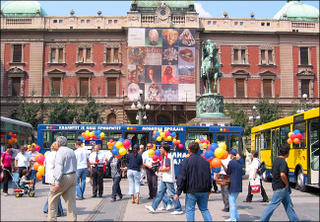
The National Museum in Republic Square, Belgrade, Serbia.
"Six years after NATO bombed it, the Serbian capital pulses with the electric energy of youth and a nonstop music scene."
Seth Sherwood "Belgrade Rocks" (Travel) Nytimes.com October 16, 2005.
*
Eighteen months ago, on the night train from Odesa to Lviv, a Serbian pharmacist berated America and the West, in front of my Russian/Ukrainian Jewish mathematician fellow travellers and me, for four hours. Her father had been blinded by the bombing, and her 8-year old nephew had lost both of his legs.
Photo credit: Ed Alcock for The New York Times
In Memorium, Alexander Yakovlev
"Alexander Yakovlev, a key architect of former President Mikhail Gorbachev's political reforms of perestroika and glasnost that shook the last years of the Soviet Union, died Tuesday, according to a foundation he headed. He was 81....
Yakovlev, who joined the Soviet Communist Party's ruling Politburo in the mid-1980s, was known as the "godfather of glasnost" for spearheading Gorbachev's policy of openness that gradually lifted the heavy hand of the state off the press and individual speech.
That program, and perestroika, which means "restructuring," were keys to Gorbachev's efforts to liberalize society and expose past crimes of the Soviet regime.
Some believe those reforms set in motion the process that led to the Soviet Union's dissolution in 1991."
Vladimir Isachenkov "Architect of Soviet Perestroika Dies" AP via WashingtonPost.com October 18, 2005.
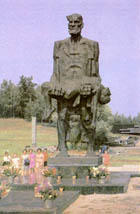
"Good people, remember: we loved life, and our Motherland, and you. We were burnt alive. This is what we want everyone to do: turn your grief and sorrow into the courage and strength that will enable you to insure peace and quiet on Earth. May never again life die in whirlpools of fire!"
Inscription on the Khatyn, Belarus War Memorial. Hundreds of villages were razed to the ground in Belarus, by the Nazis, in 1941-1944. This memorial is located 58 miles northeast of Minsk, and the bronze figure of an elderly man carrying the body of a child is by Selikhanov.
Source: The People's Feat. Monuments of the Great Patriotic War. Compiled and edited by V.A.Golikov. The Publishing House of Political Literature. Moscow. 1984.
Yakovlev, who joined the Soviet Communist Party's ruling Politburo in the mid-1980s, was known as the "godfather of glasnost" for spearheading Gorbachev's policy of openness that gradually lifted the heavy hand of the state off the press and individual speech.
That program, and perestroika, which means "restructuring," were keys to Gorbachev's efforts to liberalize society and expose past crimes of the Soviet regime.
Some believe those reforms set in motion the process that led to the Soviet Union's dissolution in 1991."
Vladimir Isachenkov "Architect of Soviet Perestroika Dies" AP via WashingtonPost.com October 18, 2005.

"Good people, remember: we loved life, and our Motherland, and you. We were burnt alive. This is what we want everyone to do: turn your grief and sorrow into the courage and strength that will enable you to insure peace and quiet on Earth. May never again life die in whirlpools of fire!"
Inscription on the Khatyn, Belarus War Memorial. Hundreds of villages were razed to the ground in Belarus, by the Nazis, in 1941-1944. This memorial is located 58 miles northeast of Minsk, and the bronze figure of an elderly man carrying the body of a child is by Selikhanov.
Source: The People's Feat. Monuments of the Great Patriotic War. Compiled and edited by V.A.Golikov. The Publishing House of Political Literature. Moscow. 1984.
Monday, October 17, 2005
Before Commander In Chief
"Hatshepsut: From Queen to Pharaoh highlights the art created during the glorious reign of the female pharaoh Hatshepsut, who shared Egypt’s throne for nearly two decades in the early New Kingdom as senior co-ruler with her nephew, Tuthmosis III. The phenomenon of a woman ruling a fundamentally patriarchal society while surrounded by male courtiers and advisors, the eventual destruction of Hatshepsut’s monuments by Tuthmosis III, and the omission of her name from later king lists have fueled debate among Egyptologists for over a century. This exhibition presents the changing interpretations of the woman, who claimed the full powers of the throne and assumed the title of “King” and the trappings of kingship. Although her reign defied long-established convention, it was accepted by her people and Egypt flourished, as seen through the superb and innovative art and architecture of her prosperous and largely peaceful rule. But after Hatshepsut’s death her name and image were ruthlessly attacked, and she was forgotten. Her reign (ca. 1479-1458 BC) was a period of immense artistic creativity and this unprecedented exhibition brings together a vast treasure of royal statuary and relief; monumental sculpture representing members of the royal court; and a wide variety of ceremonial objects, finely crafted furniture, dazzling jewelry, and other exquisite personal items that tell both the compelling story of Hatshepsut’s reign and reveal the diverse and exquisite artistic production of her time."
Fine Arts Museums of San Francisco (de Young), San Francisco, 15 October- 5 February 2006,
The Metropolitan Museum of Art, New York, 21 March–9 July 2006
Kimbell Art Museum, Fort Worth, 27 August–10 December 2006

Hatshepsut wearing the nemes headdress (detail)
Dynasty 18, reign of Hatshepsut (1473-1458 BC)
Red granite, H 66 inches
The Metropolitan Museum of Art
Text and Photo Credit: Fine Arts Museums of San Francisco and The Metropolitan Museum of Art
Fine Arts Museums of San Francisco (de Young), San Francisco, 15 October- 5 February 2006,
The Metropolitan Museum of Art, New York, 21 March–9 July 2006
Kimbell Art Museum, Fort Worth, 27 August–10 December 2006

Hatshepsut wearing the nemes headdress (detail)
Dynasty 18, reign of Hatshepsut (1473-1458 BC)
Red granite, H 66 inches
The Metropolitan Museum of Art
Text and Photo Credit: Fine Arts Museums of San Francisco and The Metropolitan Museum of Art
Teaching Us To See The World -- Renzo Piano's Design For The California Academy Of Science
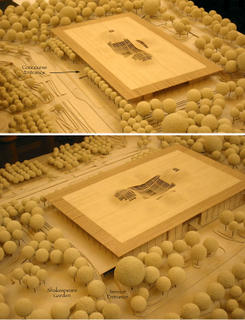
The Renzo Piano Workshop/Chong Partners "sustainable urbanist" design for the new California Academy of Sciences -- across the Golden Gate Park Music Concourse from the new de Young Museum -- will feature a living, green roof viewable from steps up from the museum to the roof level. The two biggest hills in the “living roof” will accommodate a four-story living rainforest and a state-of-the-art planetarium.
Photo Credit: California Academy of Sciences / Renzo Piano Building Workshop / Chong Partners
(with candles where permitted)
I erred below. It is the distinguished Borodin String Quartet which will be performing Beethoven's Grosse Fuge -- this Wednesday at the Library of Congress -- and not the Takacs String Quartet -- which will be performing, instead, Beethoven's String Quartet in E flat Major Opus 127 (1824) this coming Sunday at the National Gallery of Art, in Washington, D.C.
As always, the National Gallery of Art's fine program notes are available in advance at:
http://www.nga.gov/programs/pdf/mscoct23-05.pdf
The concluding paragraph of the program notes that other guest String Quartets at the NGA, in 2005-2006, will be the Pacifica, Auryn, Kronos, Kiujken, Eusia, and the NGA. Since these concerts are free, this year will provide the opportunity to study an overview of the riches of the Western String Quartet literature for the cost of round trip bus or Metro fare -- or free for walkers.
(My title to this post is from Bob Shingleton's [On an Overgrown Path] discussion with the members of the Borodin String Quartet of the order in which they perform their cycle of Shostakovich string quartets. They try to perform the last three great Shostakovich string quartets -- 14,13, and 15 -- "with candles...")
http://theovergrownpath.blogspot.com/2005/10/recycling-shostakovich-and-beethoven.html#comments
*
N. and I attended the NSO performance of Berg's Violin Concerto last Thursday, and the Vermeer String Quartet performance of Haydn and Janacek ["Intimate Letters"], at the Library of Congress, on Friday evening (after attending a screening of "Everything is Illuminated"). On Saturday and Sunday evenings, we watched, on DVD, Valery Gergiev lead the Petersburg Mariinsky (Kirov) Opera Company in Glinka's Ruslan and Lyudmila -- a 1995 coproduction with the San Francisco Opera.

Paper hot air balloons, powered by candles, in Chiang Mai, Thailand.
As always, the National Gallery of Art's fine program notes are available in advance at:
http://www.nga.gov/programs/pdf/mscoct23-05.pdf
The concluding paragraph of the program notes that other guest String Quartets at the NGA, in 2005-2006, will be the Pacifica, Auryn, Kronos, Kiujken, Eusia, and the NGA. Since these concerts are free, this year will provide the opportunity to study an overview of the riches of the Western String Quartet literature for the cost of round trip bus or Metro fare -- or free for walkers.
(My title to this post is from Bob Shingleton's [On an Overgrown Path] discussion with the members of the Borodin String Quartet of the order in which they perform their cycle of Shostakovich string quartets. They try to perform the last three great Shostakovich string quartets -- 14,13, and 15 -- "with candles...")
http://theovergrownpath.blogspot.com/2005/10/recycling-shostakovich-and-beethoven.html#comments
*
N. and I attended the NSO performance of Berg's Violin Concerto last Thursday, and the Vermeer String Quartet performance of Haydn and Janacek ["Intimate Letters"], at the Library of Congress, on Friday evening (after attending a screening of "Everything is Illuminated"). On Saturday and Sunday evenings, we watched, on DVD, Valery Gergiev lead the Petersburg Mariinsky (Kirov) Opera Company in Glinka's Ruslan and Lyudmila -- a 1995 coproduction with the San Francisco Opera.

Paper hot air balloons, powered by candles, in Chiang Mai, Thailand.
Thursday, October 13, 2005
Grosse Fuge And Beethoven's Concern For His Legacy
"Heather Carbo, a matter-of-fact librarian at an evangelical seminary outside Philadelphia, was cleaning out an archival cabinet one hot afternoon in July. It was a dirty and routine job. But there, on the bottom shelf, she stumbled across what may be one of the most important musicological finds in years.
It was a working manuscript score for a piano version of Beethoven's "Grosse Fuge," a monument of classical music. And it was in the composer's own hand, according to Sotheby's auction house. The 80-page manuscript in mainly brown ink - a furious scattering of notes across the page, with many changes and cross-outs, some so deep that the paper is punctured - dates from the final months of Beethoven's life....
Any manuscript showing a composer's self-editing gives invaluable insight into his working methods, and this is a particularly rich example. Such second thoughts are particularly revealing in the case of Beethoven, who, never satisfied, honed his ideas brutally - unlike, say, Mozart, who was typically able to spill out a large score in nearly finished form.
What's more, this manuscript is among Beethoven's last, from the period when he was stone deaf. It not only depicts his thought processes at their most introspective and his working methods at their most intense, but also gives a sense of his concern for his legacy. The "Grosse Fuge," originally part of a string quartet, had been badly treated by a baffled public, and he was evidently eager to see it live on in a form in which music lovers could play it on their pianos at home."
Daniel J. Wakin "A Historic Discovery, in Beethoven's Own Hand" Nytimes.com October 13, 2005.

Photo Credit: Shiho Fukada for The New York Times
*
The Takacs String Quartet performs Beethoven's Grosse Fuge on Sunday October 23, at 6:30 PM, at the National Gallery of Art. A program note to the free concert is available at:
http://www.nga.gov/programs/music.shtm.
Now, if only we could nationalize the Washington National Opera and the Metropolitan Opera.
It was a working manuscript score for a piano version of Beethoven's "Grosse Fuge," a monument of classical music. And it was in the composer's own hand, according to Sotheby's auction house. The 80-page manuscript in mainly brown ink - a furious scattering of notes across the page, with many changes and cross-outs, some so deep that the paper is punctured - dates from the final months of Beethoven's life....
Any manuscript showing a composer's self-editing gives invaluable insight into his working methods, and this is a particularly rich example. Such second thoughts are particularly revealing in the case of Beethoven, who, never satisfied, honed his ideas brutally - unlike, say, Mozart, who was typically able to spill out a large score in nearly finished form.
What's more, this manuscript is among Beethoven's last, from the period when he was stone deaf. It not only depicts his thought processes at their most introspective and his working methods at their most intense, but also gives a sense of his concern for his legacy. The "Grosse Fuge," originally part of a string quartet, had been badly treated by a baffled public, and he was evidently eager to see it live on in a form in which music lovers could play it on their pianos at home."
Daniel J. Wakin "A Historic Discovery, in Beethoven's Own Hand" Nytimes.com October 13, 2005.

Photo Credit: Shiho Fukada for The New York Times
*
The Takacs String Quartet performs Beethoven's Grosse Fuge on Sunday October 23, at 6:30 PM, at the National Gallery of Art. A program note to the free concert is available at:
http://www.nga.gov/programs/music.shtm.
Now, if only we could nationalize the Washington National Opera and the Metropolitan Opera.
Teaching Us To See The World -- The De Young Museum Reopens
"[San Francisco's new de Young Museum architects] Mr. Herzog and Mr. de Meuron are known for their unorthodox use of materials. Here, the entire building is clad in embossed copper panels that will weather with age. In the right light, the copper looks as luxurious as a snakeskin handbag. At other times, it has a tougher, more mysterious industrial texture.
To assert the building's urban credentials, the architects anchor it with a twisting tower. Rising above the treetops, it offers a dazzling view of the city. The twist aligns the tower's upper floors with the San Francisco street grid, visually locking the design into the distant skyline. That nod suggests an uncompromised sense of public mission. Art plays a vital role in daily life, but contemplation is not an isolated aesthetic experience, the building proclaims: it teaches us to see the world.
What is more, it breaks down the image of the museum as a temple in a garden."
Nicolai Ouroussoff "Going for Cozy Glamour in San Francisco" Nytimes.com October 13, 2005.
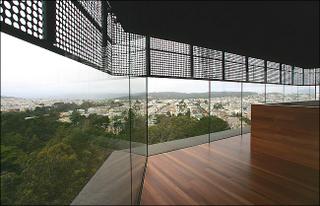
View from the new de Young Museum Tower.
Photo credit: Jim Wilson and New York Times.
*
Staatsoper Unter den Linden [Berlin]
"The house, which will come under the same financial roof as the Deutsche Oper and the Komische Oper in 2006 in an effort to cut costs, is offering its usual wealth of performances from its repertory. Several new productions are featured, including "Seven Attempted Escapes From Silence," with a libretto by Jonathan Safran Foer [author of "Everything Is Illuminated"]and seven sections by seven composers. It [premiered] on Sept. 14. Daniel Barenboim, director of the house, will lead "Boris Godunov" and "Tristan und Isolde," with sets designed by the architectural firm Herzog & de Meuron."
http://www.iht.com/articles/2005/09/02/news/traguide03.php
With thanks to Mark Swed for the Jonathan Safran Foer new operas information.
To assert the building's urban credentials, the architects anchor it with a twisting tower. Rising above the treetops, it offers a dazzling view of the city. The twist aligns the tower's upper floors with the San Francisco street grid, visually locking the design into the distant skyline. That nod suggests an uncompromised sense of public mission. Art plays a vital role in daily life, but contemplation is not an isolated aesthetic experience, the building proclaims: it teaches us to see the world.
What is more, it breaks down the image of the museum as a temple in a garden."
Nicolai Ouroussoff "Going for Cozy Glamour in San Francisco" Nytimes.com October 13, 2005.

View from the new de Young Museum Tower.
Photo credit: Jim Wilson and New York Times.
*
Staatsoper Unter den Linden [Berlin]
"The house, which will come under the same financial roof as the Deutsche Oper and the Komische Oper in 2006 in an effort to cut costs, is offering its usual wealth of performances from its repertory. Several new productions are featured, including "Seven Attempted Escapes From Silence," with a libretto by Jonathan Safran Foer [author of "Everything Is Illuminated"]and seven sections by seven composers. It [premiered] on Sept. 14. Daniel Barenboim, director of the house, will lead "Boris Godunov" and "Tristan und Isolde," with sets designed by the architectural firm Herzog & de Meuron."
http://www.iht.com/articles/2005/09/02/news/traguide03.php
With thanks to Mark Swed for the Jonathan Safran Foer new operas information.
Wednesday, October 12, 2005
"A Day's Work" by Philip Guston
The Museum of Modern Art has received a gift of 174 contemporary works from a Los Angeles real estate developer, including prime examples of paintings, sculptures and drawings by artists like Philip Guston, Vija Celmins and Christopher Wilmarth.
Since the late 1970's, the developer, Edward R. Broida, has been buying what he considered the best works by a small group of contemporary artists who were overlooked by more fashion-conscious collectors.
"At the time everyone thought I was crazy," Mr. Broida said in a telephone interview, "but the worm has turned."
Carol Vogel "The Modern Gets a Sizable Gift of Contemporary Art" October 12, 2005

"A Day's Work" by Philip Guston
Photo Credit: Museum of Modern Art
Since the late 1970's, the developer, Edward R. Broida, has been buying what he considered the best works by a small group of contemporary artists who were overlooked by more fashion-conscious collectors.
"At the time everyone thought I was crazy," Mr. Broida said in a telephone interview, "but the worm has turned."
Carol Vogel "The Modern Gets a Sizable Gift of Contemporary Art" October 12, 2005

"A Day's Work" by Philip Guston
Photo Credit: Museum of Modern Art
Black Rain, Nuclear Warfare, and Game Theory
""The most important event of the second half of the 20th century is one that didn’t happen.” With those words, Thomas Schelling marked the “stunning achievement” of 50 years without a nuclear war. No one person can claim credit but Mr Schelling has as much claim as anyone to helping prevent Armageddon. He helped to prevent war because he understood it and explained it brilliantly to others, changing the intellectual climate, inspiring a generation of strategic thinkers and, almost incidentally, saving the young discipline of game theory from irrelevance.
On Monday, Mr Schelling shared the Nobel Prize in Economics with Robert Aumann, the mathematician. The prize is long overdue but also a curious reward for a man who did almost no research as such. “If you ask what he does for a living, I have to answer that he lives by his wits,” James Coleman, the sociologist, once remarked."
Tim Harford "How an economic theory beat the atomic bomb" Financial Times October 11, 2005.

Black Rain (1988) Directed by Shohei Imamura
Based on Novel by Masuji Ibuse
Screenplay by Toshiro Ishida and Shohei Imamura
Starring Yoshiko Tanaka, Kazuo Kitamura, and Etsuko Ichihara.
"On August 6, 1945, the world's first nuclear bomb was detonated over Hiroshima. The city was levelled, some of its people were killed instantly while many suffered painful, slow deaths. A young woman named Yasuko was on her way to her uncle's home when the bomb fell. Yasuko along with her uncle and aunt trdges through the ruined city seeking refuge under the radioactive black rain which fell on Hiroshima after the blast.
Five years later many are still suffering and dying from the radiation sickness caused by the bomb. Not only were the citizens of Hiroshima greatly affected so were those who came to Hiroshima shortly after the bomb was dropped. Yasuko is considered untouchable by young men looking for wives because of her exposure to the black rain. She is in love with a man whose war experiences have left him neurotic and bitter but this love is doomed.
As those around her begin to fall victim to radiation sickness, Yasuko realizes that she too is suffering from radiation sickness. Her uncle who is not showing signs of illness prays for Yasuko's release from her pain."
Text and Photo Credit: Embassy of Japan (Canada).
On Monday, Mr Schelling shared the Nobel Prize in Economics with Robert Aumann, the mathematician. The prize is long overdue but also a curious reward for a man who did almost no research as such. “If you ask what he does for a living, I have to answer that he lives by his wits,” James Coleman, the sociologist, once remarked."
Tim Harford "How an economic theory beat the atomic bomb" Financial Times October 11, 2005.

Black Rain (1988) Directed by Shohei Imamura
Based on Novel by Masuji Ibuse
Screenplay by Toshiro Ishida and Shohei Imamura
Starring Yoshiko Tanaka, Kazuo Kitamura, and Etsuko Ichihara.
"On August 6, 1945, the world's first nuclear bomb was detonated over Hiroshima. The city was levelled, some of its people were killed instantly while many suffered painful, slow deaths. A young woman named Yasuko was on her way to her uncle's home when the bomb fell. Yasuko along with her uncle and aunt trdges through the ruined city seeking refuge under the radioactive black rain which fell on Hiroshima after the blast.
Five years later many are still suffering and dying from the radiation sickness caused by the bomb. Not only were the citizens of Hiroshima greatly affected so were those who came to Hiroshima shortly after the bomb was dropped. Yasuko is considered untouchable by young men looking for wives because of her exposure to the black rain. She is in love with a man whose war experiences have left him neurotic and bitter but this love is doomed.
As those around her begin to fall victim to radiation sickness, Yasuko realizes that she too is suffering from radiation sickness. Her uncle who is not showing signs of illness prays for Yasuko's release from her pain."
Text and Photo Credit: Embassy of Japan (Canada).
Tuesday, October 11, 2005
Human Aspiration, Fragility, and Triumph in Western Orchestral Culture
"The fascinating all-American program opened with Ives's well-known "Three Places in New England." But the luminous and wondrously strange performance made this cutting-edge score seem new. Mr. Levine was less concerned with evoking the imagery that inspired each movement than with enticing the audience to hear Ives as a major modernist - an American eccentric, yes, but a savvy craftsman and a visionary composer. In the opening piece, "The 'St. Gaudens' in Boston Common," those thick, hazy, string chords shimmered with pungent polytonal dissonance and mystical allure. Ives seemed an American Berg. The string tone was so plush you wanted to wrap yourself in it. The "Putnam's Camp" movement, with its din of brass bands, and "The Housatonic at Stockbridge," with its multi-layered harmonies and haunted evocations of church music in the distance, were also a revelation.
Elliott Carter, who turns 97 in December...is still composing ingenious works. Mr. Levine conducted the New York premiere of "Three Illusions" (2004), short movements (three minutes each) that bustle with invention, instrumental colorings and Mr. Carter's distinctly complex and alluring astringent harmonic language. Something must have gone not quite right in the second piece, for Mr. Levine asked the audience if the orchestra could play it again, and it did, this time getting a big thumb's up from the maestro and a rousing ovation from the audience."
Anthony Tommasini "Levine and the Boston, Still Made for Each Other" New York Times October 10, 2005.
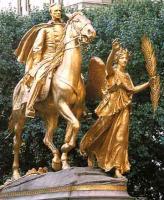
Elliott Carter, who turns 97 in December...is still composing ingenious works. Mr. Levine conducted the New York premiere of "Three Illusions" (2004), short movements (three minutes each) that bustle with invention, instrumental colorings and Mr. Carter's distinctly complex and alluring astringent harmonic language. Something must have gone not quite right in the second piece, for Mr. Levine asked the audience if the orchestra could play it again, and it did, this time getting a big thumb's up from the maestro and a rousing ovation from the audience."
Anthony Tommasini "Levine and the Boston, Still Made for Each Other" New York Times October 10, 2005.

Western Orchestral Culture: Live in L.A.
"The Walt Disney Concert Hall has proved an inspirer of lasting, invigorating music. Steven Stucky's Second Concerto for Orchestra received a Pulitzer Prize. Steve Reich's "You Are (Variations)" was a Pulitzer finalist and has just been released on a winning Nonesuch disc. Esa-Pekka Salonen's "Wing on Wing" highlights a high-profile Deutsche Grammophon recording. John Adams' "Dharma at Big Sur" has lots more performances lined up and a recording comes out next year.
Magnus Lindberg's "Sculpture," which the Los Angeles Philharmonic commissioned (in partnership with the Koussevitzky Music Foundation) and premiered Thursday night, seems just as likely to last. The score is sophisticated yet immediately engrossing ...
The Finnish composer is a great maker of bracing sonic structures, some of which can get enjoyably out of hand. ... His instinct was to write fanfares. The hall makes him happy and his angels wanted to whoop it up. His devils kept him in check. He left out the violins and concentrated on low instruments, lest he sound too blatantly enthusiastic.
The result is a lot of low instruments — pairs of contrabassoons, pairs of tubas and Wagner tubas, pairs of pianos and harps mellowing out the whoops for joy. The violas are the highest strings, which made principal violist Dale Hikawa Silverman concertmaster for the performance.
At the end the organ came rumbling in, lingering "Zarathustra"-like in its low register. Tubas and other brass instruments took positions around the hall. The seats and floors vibrated at frequencies that felt healthful for the body. ...
The orchestral writing is that of a master. Disney Hall is especially happy with bass notes, and Lindberg gave it its fill. The bouncy fanfare figures are not blatant but more like a filigree. The instrumental texture is often fast-moving and complex. A Sibelius sense of mysterious winds blowing everything around is strong at first.
In the middle, "Sculpture" turns into a miniature concerto for orchestra, focusing on different instrumental sections competing to be the most dazzling. The piece climaxes with rousing Stravinskyan rhythms. The score's 23 minutes fly by. The performance was spectacular."
Mark Swed "A captivating new 'Sculpture' in sound" L.A. Times October 8, 2005
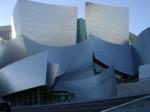
Magnus Lindberg's "Sculpture," which the Los Angeles Philharmonic commissioned (in partnership with the Koussevitzky Music Foundation) and premiered Thursday night, seems just as likely to last. The score is sophisticated yet immediately engrossing ...
The Finnish composer is a great maker of bracing sonic structures, some of which can get enjoyably out of hand. ... His instinct was to write fanfares. The hall makes him happy and his angels wanted to whoop it up. His devils kept him in check. He left out the violins and concentrated on low instruments, lest he sound too blatantly enthusiastic.
The result is a lot of low instruments — pairs of contrabassoons, pairs of tubas and Wagner tubas, pairs of pianos and harps mellowing out the whoops for joy. The violas are the highest strings, which made principal violist Dale Hikawa Silverman concertmaster for the performance.
At the end the organ came rumbling in, lingering "Zarathustra"-like in its low register. Tubas and other brass instruments took positions around the hall. The seats and floors vibrated at frequencies that felt healthful for the body. ...
The orchestral writing is that of a master. Disney Hall is especially happy with bass notes, and Lindberg gave it its fill. The bouncy fanfare figures are not blatant but more like a filigree. The instrumental texture is often fast-moving and complex. A Sibelius sense of mysterious winds blowing everything around is strong at first.
In the middle, "Sculpture" turns into a miniature concerto for orchestra, focusing on different instrumental sections competing to be the most dazzling. The piece climaxes with rousing Stravinskyan rhythms. The score's 23 minutes fly by. The performance was spectacular."
Mark Swed "A captivating new 'Sculpture' in sound" L.A. Times October 8, 2005

Globalization of Inequality
"China's Communist Party leadership, concluding its annual planning session, has approved a new economic blueprint intended to address the country's yawning wealth gap and reduce "outstanding contradictions" that have led to outbreaks of social unrest.
The president and Communist Party chief, Hu Jintao, put his oratorical stamp on China's forthcoming five-year economic plan, his first since becoming the party's leader in 2002. The work report describing the plan, read verbatim on the main evening newscast today, was filled with Mr. Hu's slogans, such as building a "harmonious society" through "scientific development." ...
China's market-oriented economy has partly outgrown the traditional five-year planning documents that used to control nearly all allocations of money, resources and talent. But the planning process is still closely watched because it reflects the priorities of the leadership, which controls the financial system and most strategic industries, like steel and energy.
The leadership is also alarmed by a surge of protests, especially in the countryside, where corruption, land grabs by government agencies and private developers, a crumbling health care system and worsening pollution have sparked the worst outbreak of unrest since the Beijing democracy demonstration in 1989. ... The number of mass protests in China increased to 74,000 last year from 10,000 in 1994, according to police figures."
Joseph Kahn China Approves New 5-Year Plan to Ease Wealth Gap New York Times October 11, 2005.

Shanghai, China
The president and Communist Party chief, Hu Jintao, put his oratorical stamp on China's forthcoming five-year economic plan, his first since becoming the party's leader in 2002. The work report describing the plan, read verbatim on the main evening newscast today, was filled with Mr. Hu's slogans, such as building a "harmonious society" through "scientific development." ...
China's market-oriented economy has partly outgrown the traditional five-year planning documents that used to control nearly all allocations of money, resources and talent. But the planning process is still closely watched because it reflects the priorities of the leadership, which controls the financial system and most strategic industries, like steel and energy.
The leadership is also alarmed by a surge of protests, especially in the countryside, where corruption, land grabs by government agencies and private developers, a crumbling health care system and worsening pollution have sparked the worst outbreak of unrest since the Beijing democracy demonstration in 1989. ... The number of mass protests in China increased to 74,000 last year from 10,000 in 1994, according to police figures."
Joseph Kahn China Approves New 5-Year Plan to Ease Wealth Gap New York Times October 11, 2005.

Shanghai, China
Renaissance of the Hydraulis
"The hydraulis is the first keyboard musical instrument in the history and the ancestor of the later church organ. It consisted of one or more sets of metal pipes of different sizes, which were supplied with air at constant pressure by a hydraulic mechanical device and activated, so as to produce sound, by special keys. The Hydraulis was a simple but ingenious structure, which demonstrates the high level of technological thought, developed in the ancient Greek world. According to the ancient accounts of Athenaeus, of Philon of Byzantium and, indirectly, of Vitruvius, the Hydraulis was invented by the famous engineer Ctesibius, who lived in Alexandria in the third century BC. Apart from the many interesting ancient references to the hydraulis, two detailed descriptions have survived: that of Vitruvius (De Architectura x, 8) and Heron of Alexandria (Pneumatica, I, 42)...
The hydraulis, after its invention, spreads quickly in the Hellenistic and Roman world. In Rome, it was played in theatres, festivals and even in the amphitheaters, and became the favorite instrument of the ruling class and of emperors such as Nero...
Little by little instruments began to appear in which the hydraulic mechanism was replaced by bellows. By the early third century AD, the two types must have been almost equally represented. After the late fifth century AD, with the collapse of the Western Empire beneath the barbarian invasions, the organ disappeared in Western Europe. It lived on in the East, however, in the Byzantine Empire, whose capital was now Constantinolpe. By this time, the bellows organ had prevailed. At the Imperial court in Constantinople, the organ was a symbol of prestige, playing music at public festivals and during the visit of foreign quests, in order to impress them. The Emperor Constantine Porphyrogennetos (912-959) formally established the organ in court protocol and decreed that it was to play at parades and during specific ceremonies in the Great Palace and the Hippodrome. In 757, the Emperor Constantine II Copronymos sent an organ as a gift to Pepin the Short, King of the Franks and father of Charlemange. Over time, the organ became part of the musical tradition of the West, was accepted by the Catholic Church, and developed into the church organ familiar to us today. In Byzantium, it remained in use but was confined to the Imperial Palace. After the fall of Constantinople to the Turks in 1453, it disappeared."
Text and Photo Credit: Paraschos Corporation www.paraschos.gr

The Hydraulis was played at the Athens 2004 Olympics, and will be played on Sunday October 16, 2005, at the Corcoran Gallery of Art, in a program in association with the Embassy of Greece, Washington, D.C.
The hydraulis, after its invention, spreads quickly in the Hellenistic and Roman world. In Rome, it was played in theatres, festivals and even in the amphitheaters, and became the favorite instrument of the ruling class and of emperors such as Nero...
Little by little instruments began to appear in which the hydraulic mechanism was replaced by bellows. By the early third century AD, the two types must have been almost equally represented. After the late fifth century AD, with the collapse of the Western Empire beneath the barbarian invasions, the organ disappeared in Western Europe. It lived on in the East, however, in the Byzantine Empire, whose capital was now Constantinolpe. By this time, the bellows organ had prevailed. At the Imperial court in Constantinople, the organ was a symbol of prestige, playing music at public festivals and during the visit of foreign quests, in order to impress them. The Emperor Constantine Porphyrogennetos (912-959) formally established the organ in court protocol and decreed that it was to play at parades and during specific ceremonies in the Great Palace and the Hippodrome. In 757, the Emperor Constantine II Copronymos sent an organ as a gift to Pepin the Short, King of the Franks and father of Charlemange. Over time, the organ became part of the musical tradition of the West, was accepted by the Catholic Church, and developed into the church organ familiar to us today. In Byzantium, it remained in use but was confined to the Imperial Palace. After the fall of Constantinople to the Turks in 1453, it disappeared."
Text and Photo Credit: Paraschos Corporation www.paraschos.gr

The Hydraulis was played at the Athens 2004 Olympics, and will be played on Sunday October 16, 2005, at the Corcoran Gallery of Art, in a program in association with the Embassy of Greece, Washington, D.C.
Friday, October 07, 2005
Rolls Royce Opens Shop At One Red Square, Next To The Kremlin
"Olga Sorokina picks at a bowl of kasha at the Vogue Cafe in Moscow and contemplates her next shopping move. The languid 20-year-old is bemoaning the state of the collections here, compared with the choice she sees in Milan and Miami. But she does like the jewellery in Moscow, she says, and she’s been thinking of buying a ring. “I saw it in a magazine,” says Sorokina, who is married to the chairman of a Russian bank. “I’ve never bought Cartier in Moscow - my last ring I bought in Paris - but I like this one.” Outside is her Porsche Cayenne, her first car, which she is too nervous to drive. So it is her driver who takes us to Stoleshnikov Pereulok, a cobblestone alley containing a cluster of luxury boutiques. He waits at the top while Sorokina swoops into Cartier and buys a i10,000 [dollars or euros depending on which is of higher value] gold cheetah-head ring with emerald eyes. The cheetah’s nose rests heavily on her small knuckle. “Of course I’ll wear it very rarely,” Sorokina sighs, as if already bored. “Maybe once or twice.”
Sorokina, who travels frequently, finds that the pleasures of most of Moscow’s luxury shops have palled. But she still loves the clothes at Roberto Cavalli, which she teeters towards, in extravagantly high-heeled tangerine sandals, over the cobblestones of Tretyakovsky Proyezd, Moscow’s shortest and most expensive street. She tries on a i1,500 peacock-print skirt; it is a little big in the hips, but she buys it anyway. Her gold card is extracted from a Louis Vuitton wallet, itself housed in an oversized Fendi bag
Two years ago, Sorokina lived in a small, poor village in Belarus and couldn’t tell Prada from Gap. “There are fashion magazines in Belarus, but no one can afford to buy them,” she says. “I knew I wanted to get out and be a model in Moscow.”
...
Russians are not living as long as they used to under the Soviet Union - the World Health Organisation says that a Russian male’s current life expectancy is 56 - while state statistics show that the average monthly income in Moscow is only about $350, and less in the rest of the country."
Nora FitzGerald "Lenin wouldn’t like it" [Arts & Weekend/Billionaires] Financial Times October 7, 2005.

An almost hidden corner of The Kremlin, Moscow
Photo credit: Maxximum Sound and Lights
Sorokina, who travels frequently, finds that the pleasures of most of Moscow’s luxury shops have palled. But she still loves the clothes at Roberto Cavalli, which she teeters towards, in extravagantly high-heeled tangerine sandals, over the cobblestones of Tretyakovsky Proyezd, Moscow’s shortest and most expensive street. She tries on a i1,500 peacock-print skirt; it is a little big in the hips, but she buys it anyway. Her gold card is extracted from a Louis Vuitton wallet, itself housed in an oversized Fendi bag
Two years ago, Sorokina lived in a small, poor village in Belarus and couldn’t tell Prada from Gap. “There are fashion magazines in Belarus, but no one can afford to buy them,” she says. “I knew I wanted to get out and be a model in Moscow.”
...
Russians are not living as long as they used to under the Soviet Union - the World Health Organisation says that a Russian male’s current life expectancy is 56 - while state statistics show that the average monthly income in Moscow is only about $350, and less in the rest of the country."
Nora FitzGerald "Lenin wouldn’t like it" [Arts & Weekend/Billionaires] Financial Times October 7, 2005.

An almost hidden corner of The Kremlin, Moscow
Photo credit: Maxximum Sound and Lights
Adolf Cluss (1825-1905) : Idealism and Pragmatism in Architecture
"German-American architect Adolf Cluss (1825-1905) came from a Heilbronn, Germany family of master builders. He left Heilbronn as a young man to be a traveling carpenter.
In Brussels, he met Karl Marx and joined the early Communist movement there. He also went to Paris and to Mainz, where he began work in 1846 as an architect, planning the railroad to Ludwigshafen. In the spring of 1848, he became a central figure in the revolutionary movement, as a co-founder and Secretary of the Workers' Council. Soon after, in summer of 1848, he left Germany, and on September 15, 1848 arrived in New York via the immigrant ship "Zürich."
Adolf Cluss worked in the USA first as an engineer - for the Navy, among other employers - then in Washington as an architect, where he worked largely in red brick and red sandstone. He broke off from the Communist movement in 1858.
Beginning in the 1860's, Adolf Cluss worked as an architect in Washington and completed commissions for public buildings - public schools (separate schools for white and black children), museums, office buildings, market halls, and residences. As of 1890, at the end of his career, most of the public buildings in the American capitol could be attributed to Cluss. Of his seventy buildings, seven still stand today, including the Arts and Industries Building of the Smithsonian Institution on the National Mall, the downtown Masonic Temple, the Eastern Market, the Franklin School (for white children), and Sumner School (for black children), and the downtown Baptist Church (Northern progressive).
Exhibitions in Washington, D.C. and in Heilbronn mark the 100th anniversary of his death. Public events in both Washington and Heilbronn focus on Adolf Cluss's life and work.
Source text and Photo credit: http://www.adolf-cluss.org/
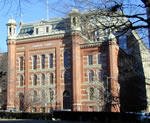
Adolf Cluss Franklin Public School for White Children, Washington, D.C. (Presently, a public shelter for homeless [black] men; and proposed to be soon converted to a small luxury "boutique" hotel.) From the top floor of this public building, Alexander Graham Bell first transmitted a wireless telephone message over a thin beam of light.
In Brussels, he met Karl Marx and joined the early Communist movement there. He also went to Paris and to Mainz, where he began work in 1846 as an architect, planning the railroad to Ludwigshafen. In the spring of 1848, he became a central figure in the revolutionary movement, as a co-founder and Secretary of the Workers' Council. Soon after, in summer of 1848, he left Germany, and on September 15, 1848 arrived in New York via the immigrant ship "Zürich."
Adolf Cluss worked in the USA first as an engineer - for the Navy, among other employers - then in Washington as an architect, where he worked largely in red brick and red sandstone. He broke off from the Communist movement in 1858.
Beginning in the 1860's, Adolf Cluss worked as an architect in Washington and completed commissions for public buildings - public schools (separate schools for white and black children), museums, office buildings, market halls, and residences. As of 1890, at the end of his career, most of the public buildings in the American capitol could be attributed to Cluss. Of his seventy buildings, seven still stand today, including the Arts and Industries Building of the Smithsonian Institution on the National Mall, the downtown Masonic Temple, the Eastern Market, the Franklin School (for white children), and Sumner School (for black children), and the downtown Baptist Church (Northern progressive).
Exhibitions in Washington, D.C. and in Heilbronn mark the 100th anniversary of his death. Public events in both Washington and Heilbronn focus on Adolf Cluss's life and work.
Source text and Photo credit: http://www.adolf-cluss.org/

Adolf Cluss Franklin Public School for White Children, Washington, D.C. (Presently, a public shelter for homeless [black] men; and proposed to be soon converted to a small luxury "boutique" hotel.) From the top floor of this public building, Alexander Graham Bell first transmitted a wireless telephone message over a thin beam of light.
Caution: Men (and Women) Working For Peace
"Mohamed ElBaradei and the International Atomic Energy Agency won the 2005 Nobel Peace Prize on Friday for their drive to curb the spread of atomic weapons by using diplomacy to resolve standoffs with Iran and North Korea over their nuclear programs.
The Nobel Committee's decision lent support to negotiations and inspections, not military action, as the best way to handle volatile nations. It also was seen as a message to the Bush administration, which invaded Iraq after claiming U.N. efforts to eradicate Saddam Hussein's nuclear ambitions had failed and which opposed ElBaradei's appointment to another term.
The Nobel committee said ElBaradei and the IAEA should be recognized for addressing one of the greatest dangers facing the world.
"At a time when the threat of nuclear arms is again increasing, the Norwegian Nobel Committee wishes to underline that this threat must be met through the broadest possible international cooperation. This principle finds its clearest expression today in the work of the IAEA and its director general," the committee said.
Doug Mellgren U.N. Nuke Watchdog Wins Nobel Peace Prize Associated Press October 7, 2005 via WashingntonPost.com

A Public Talk -- "Global Peace Through Compassion" -- by His Holiness the Dalai Lama, will take place in Washington, D.C. on Sunday afternoon, November 13 2005.
http://www.dalailamadc.org/
Photo credit: Jeff Miller and the University of Wisconsin.
The Nobel Committee's decision lent support to negotiations and inspections, not military action, as the best way to handle volatile nations. It also was seen as a message to the Bush administration, which invaded Iraq after claiming U.N. efforts to eradicate Saddam Hussein's nuclear ambitions had failed and which opposed ElBaradei's appointment to another term.
The Nobel committee said ElBaradei and the IAEA should be recognized for addressing one of the greatest dangers facing the world.
"At a time when the threat of nuclear arms is again increasing, the Norwegian Nobel Committee wishes to underline that this threat must be met through the broadest possible international cooperation. This principle finds its clearest expression today in the work of the IAEA and its director general," the committee said.
Doug Mellgren U.N. Nuke Watchdog Wins Nobel Peace Prize Associated Press October 7, 2005 via WashingntonPost.com

A Public Talk -- "Global Peace Through Compassion" -- by His Holiness the Dalai Lama, will take place in Washington, D.C. on Sunday afternoon, November 13 2005.
http://www.dalailamadc.org/
Photo credit: Jeff Miller and the University of Wisconsin.
Wednesday, October 05, 2005
100 Million Illiterate and Unemployed Young Talents
"Today's youth are the best educated generation in history even though 130 million are still illiterate, according to a new U.N. report that urges greater investment to ensure universal primary schooling.
The U.N. World Youth Report 2005, which provided a snapshot of the 1.2 billion young people aged 15 to 24, found that more than 500 million youths live on less than $2 a day and a record 88 million who were seeking work are unemployed.
The report, produced by U.N. staff in collaboration with experts and young people, relied on global statistics from recent years provided by the United Nations, the World Bank and other sources. Because of reporting differences in various countries, the figures give a broad overview of the world's youth but are not definitive."
United Nations via AP and nytimes.com
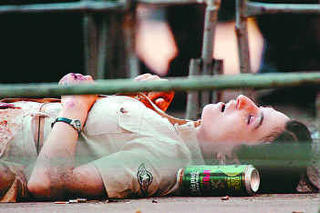
Dead Chechen Suicide Bomber
The U.N. World Youth Report 2005, which provided a snapshot of the 1.2 billion young people aged 15 to 24, found that more than 500 million youths live on less than $2 a day and a record 88 million who were seeking work are unemployed.
The report, produced by U.N. staff in collaboration with experts and young people, relied on global statistics from recent years provided by the United Nations, the World Bank and other sources. Because of reporting differences in various countries, the figures give a broad overview of the world's youth but are not definitive."
United Nations via AP and nytimes.com

Dead Chechen Suicide Bomber
Arnold Schoenberg 1874-1951
In cooperation with the Arnold Schoenberg Center Vienna, the Austrian Embassy and the Austrian Cultural Forum (Washington) present the travelling exhibition Arnold Schoenberg 1874-1951: An Exhibition for Hearing. Curators Nuria Schoenberg Nono and Lawrence A. Schoenberg have arranged this exhibition, to be accompanied by a detailed audio program, into twelve Teatrinos -- or little theaters. Also available on-line is a searchable data-base of thousands of Schoenberg's letters -- including one from 1923, to Russian painter Wassily Kandisky then at the German Bauhaus, warning of the anti-Semitism of "Hittler" [sic]. This database is being published by the Schoenberg Center Vienna, in association with the Library of Congress, and Belmont Publishers, Los Angeles.
www.schoenberg.at

Arnold Schoenberg Red Gaze 1910. A self-portrait from the composer's most productive period.
www.schoenberg.at

Arnold Schoenberg Red Gaze 1910. A self-portrait from the composer's most productive period.
Welcome Back To Washington Ivan Fischer!
"The National Symphony Orchestra has named Ivan Fischer as its principal guest conductor, starting with the 2006-07 season, the orchestra announced yesterday. The initial contract will be for three years, meaning that Fischer may be the senior artistic figure within the orchestra when the present music director, Leonard Slatkin, steps down at the end of the 2007-08 season. Fischer will lead two weeks in 2006-07, and a minimum of three weeks in each of the two subsequent seasons."

Text and Photo Credits: Tim Page Washington Post October 5, 2005; and the National Symphony Orchestra

Text and Photo Credits: Tim Page Washington Post October 5, 2005; and the National Symphony Orchestra
Tuesday, October 04, 2005
Happiness on Earth
"What is happiness? In the United States and in many other industrialized countries, it is often equated with money.
Economists measure consumer confidence on the assumption that the resulting figure says something about progress and public welfare. The gross domestic product, or G.D.P., is routinely used as shorthand for the well-being of a nation.
But the small Himalayan kingdom of Bhutan has been trying out a different idea.
In 1972, concerned about the problems afflicting other developing countries that focused only on economic growth, Bhutan's newly crowned leader, King Jigme Singye Wangchuck, decided to make his nation's priority not its G.D.P. but its G.N.H., or gross national happiness.
Bhutan, the king said, needed to ensure that prosperity was shared across society and that it was balanced against preserving cultural traditions, protecting the environment and maintaining a responsive government. The king, now 49, has been instituting policies aimed at accomplishing these goals.
Now Bhutan's example, while still a work in progress, is serving as a catalyst for far broader discussions of national well-being.
Around the world, a growing number of economists, social scientists, corporate leaders and bureaucrats are trying to develop measurements that take into account not just the flow of money but also access to health care, free time with family, conservation of natural resources and other noneconomic factors.... It is a concept grounded in Buddhist doctrine, and even a decade ago it might have been dismissed by most economists and international policy experts as naive idealism."
Andrew C. Revkin The New York Times October 4, 2005

Farmer in Bali, Indonesia
Photo credit:
Economists measure consumer confidence on the assumption that the resulting figure says something about progress and public welfare. The gross domestic product, or G.D.P., is routinely used as shorthand for the well-being of a nation.
But the small Himalayan kingdom of Bhutan has been trying out a different idea.
In 1972, concerned about the problems afflicting other developing countries that focused only on economic growth, Bhutan's newly crowned leader, King Jigme Singye Wangchuck, decided to make his nation's priority not its G.D.P. but its G.N.H., or gross national happiness.
Bhutan, the king said, needed to ensure that prosperity was shared across society and that it was balanced against preserving cultural traditions, protecting the environment and maintaining a responsive government. The king, now 49, has been instituting policies aimed at accomplishing these goals.
Now Bhutan's example, while still a work in progress, is serving as a catalyst for far broader discussions of national well-being.
Around the world, a growing number of economists, social scientists, corporate leaders and bureaucrats are trying to develop measurements that take into account not just the flow of money but also access to health care, free time with family, conservation of natural resources and other noneconomic factors.... It is a concept grounded in Buddhist doctrine, and even a decade ago it might have been dismissed by most economists and international policy experts as naive idealism."
Andrew C. Revkin The New York Times October 4, 2005

Farmer in Bali, Indonesia
Photo credit:
Sputnik and the International Geophysical Year
On October 4, 1957, the space age began as the Soviet Union launched Sputnik, the first man-made satellite, into orbit. Happy 48th birthday, space age!!
"History changed on October 4, 1957, when the Soviet Union successfully launched Sputnik I. The world's first artificial satellite was about the size of a basketball, weighed only 183 pounds, and took about 98 minutes to orbit the Earth on its elliptical path. That launch ushered in new political, military, technological, and scientific developments. While the Sputnik launch was a single event, it marked the start of the space age and the U.S.-U.S.S.R space race.
The story begins in 1952, when the International Council of Scientific Unions decided to establish July 1, 1957, to December 31, 1958, as the International Geophysical Year (IGY) because the scientists knew that the cycles of solar activity would be at a high point then. In October 1954, the council adopted a resolution calling for artificial satellites to be launched during the IGY to map the Earth's surface."
Source: NASA
http://www.hq.nasa.gov/office/pao/History/sputnik/
Telemetry from Sputnik I as it passed over the Earth(WAV File)
http://www.hq.nasa.gov/office/pao/History/sputnik/sputnik.wav

"History changed on October 4, 1957, when the Soviet Union successfully launched Sputnik I. The world's first artificial satellite was about the size of a basketball, weighed only 183 pounds, and took about 98 minutes to orbit the Earth on its elliptical path. That launch ushered in new political, military, technological, and scientific developments. While the Sputnik launch was a single event, it marked the start of the space age and the U.S.-U.S.S.R space race.
The story begins in 1952, when the International Council of Scientific Unions decided to establish July 1, 1957, to December 31, 1958, as the International Geophysical Year (IGY) because the scientists knew that the cycles of solar activity would be at a high point then. In October 1954, the council adopted a resolution calling for artificial satellites to be launched during the IGY to map the Earth's surface."
Source: NASA
http://www.hq.nasa.gov/office/pao/History/sputnik/
Telemetry from Sputnik I as it passed over the Earth(WAV File)
http://www.hq.nasa.gov/office/pao/History/sputnik/sputnik.wav





